#did michael mann even write that first scene or did it come from the other episode that uses it and just got tacked on here
Text
i don't have a point here except ???, but i realized today that starsky & hutch episode the psychic a) was written by micheal mann of (among many other things) classic crime thriller heat fame, and b) contains a baffling amount of (references to) crossdressing. it's one of the two episodes that opens with starsky and hutch chasing a guy in a dress (which gives us the "well i don't know, you('d) look rather nice in basic black and pearls" starsky-to-hutch line), later on they interrupt a robbery being committed by ANOTHER guy in a dress (and grey wig, posing as an old lady - presumably with the intent to disguise his identity rather than express some part of it, but who knows), and THEN they meet a hot lady mechanic who among many fast lines says to starsky "i'm really a basketball player in drag. whatever turns you on, honey" (interestingly timely, considering starsky's earlier comment about hutch). and finally, not entirely related but also not unrelated, there's these people at a laundromat hutch hits up on his mad phone chase at the end of the episode:
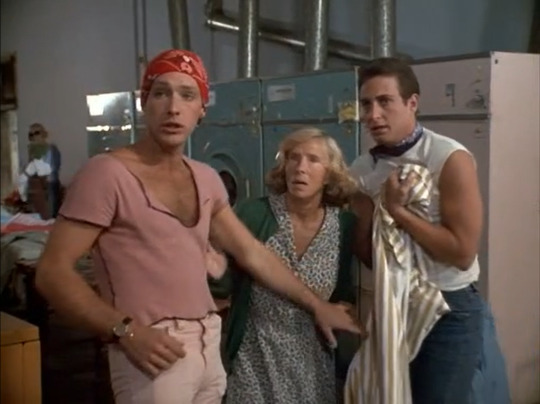
so yeah. ???.
#haven't revisited this episode in a long time (if ever?) because maybe-THIS-psychic-is-REAL plots... are not among my favorite#(due south has an episode very similar to this and i'm blaming starsky and hutch for it. c'mon guys.)#but!! everything else about this episode is FUN actually!! slightly wacky lots of great s&h interaction and oooh that chase at the end#but i just. what's with this one thing. is this an attempt to be clever with a theme? as in. deception maybe. or you don't know what's real#or a kinder interpretation: there are things you may not understand in this world but that doesn't mean they're not true for someone else?#or is it meant as a recurring joke? is it literally pure coincidence?#did michael mann even write that first scene or did it come from the other episode that uses it and just got tacked on here#which suddenly makes this episode seem like it's Doing something when it wasn't supposed to#i have! many questions! among which is. why the hell was starsky in such a bad mood. what happened#... are you telling me he's psychic too and he had a deep dark feeling hutch was going to almost die later on?#i feel like i need to make a psych reference here but i haven't watched enough of the show to be clever about it. 🍍 i guess#*#starsky and hutch
32 notes
·
View notes
Photo

Natural Woman.
Filmmaking power-couple Julia Hart and Jordan Horowitz chat to Jack Moulton about exploring untouched female perspectives in genre films, a fateful viewing of Michael Mann’s Thief, the humbling magic of babies on set, and Letterboxd’s small role in their filmmaking process.
I’m Your Woman puts the gangster’s moll, a classically underwritten character, at the heart of the action. We barely meet the gangster himself in this taut, 1970s-set crime thriller from director Julia Hart and her co-writer and producer husband Jordan Horowitz. Rachel Brosnahan occupies a tense and unusual space as Jean, wife of Eddie, a no-good chap who turns up one day with a very young baby then abruptly disappears, leaving her to raise this unnamed child.
In other versions of the story, we’d follow Eddie to a guns-blazing conclusion, but this is a Hart-Horowitz jam, so we’re quickly on the run with Jean and the baby, and we stay with her. I’m Your Woman is a compelling, unsettling twist on the genre. “What impressed me most … was how well it keeps its cards close to the vest,” writes Mikey on Letterboxd. It’s also an empathetic portrayal of new-motherhood in all its exhausting confusion, where getting a baby clean, fed and sleeping is as much a priority as finding the next safe house. “Despite valuing tension quite highly, Julia Hart still has the wherewithal to let it sit in its more tender and thoughtful moments,” writes Paul. “The ending really sneaks up on you in terms of the specific feeling it elicits.”

Marsha Stephanie Blake and Rachel Brosnahan in ‘I’m Your Woman’.
Hart and Horowitz have children, aged two and six, who have grown up around film sets. Before becoming a filmmaker, Hart spent her days with other people’s kids as a teacher; her 2016 debut, Miss Stevens, stars Lily Rabe as a high-school educator, but her follow-up films have been wider-ranging, from Fast Color to this year’s Stargirl. Hart credits this genre-jumping to her absolute love of movies. “I don’t have a favorite genre. I love musicals, Westerns, crime dramas, coming-of-age movies, superhero movies. It was so fun getting to learn about how to create musical numbers in Stargirl and how to direct a car chase in I’m Your Woman.”
Horowitz, meanwhile, is known for producing The Kids Are All Right and La La Land. Yes, he’s the “Guys, guys, I’m sorry, no, there’s a mistake” guy. Horowitz is also a Letterboxd member, and a hunt back through his diary reveals the date he first watched Moonlight, along with his wholesome reviews of Julia’s films. “I always tried to remember to log my movies in so many different ways,” Horowitz explains, “and then once Letterboxd came out it was a very easy solution.”
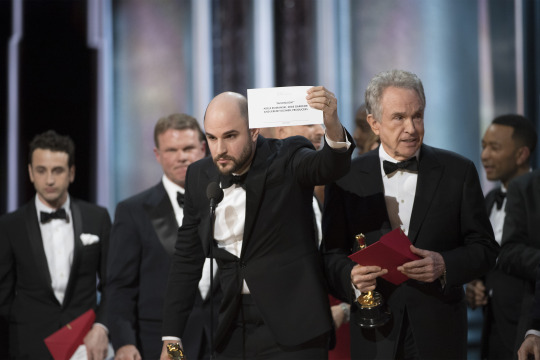
Jordan Horowitz corrects that famous Oscar mix-up.
Horowitz keeps diligent lists of references for his upcoming films, years before they’re even announced. It’s here that the roots of I’m Your Woman are found, if you’re looking closely: a fateful viewing of Michael Mann’s Thief nearly seven years ago was the primary influence on I’m Your Woman, “especially Tuesday Weld’s character, and the moment where she is basically asked to leave the movie before James Caan burns everything to the ground,” he tells me. “Our hope with this movie was to follow some of the women in those movies that don’t necessarily get the spotlight and shift the gaze of the camera to follow this car as it drives away with her in it, instead of staying with the criminal of this movie.”
Hart picks up the thread, naming Diane Keaton in The Godfather, Ali MacGraw in The Getaway, Theresa Russell in Straight Time. “Those were interesting characters played by incredible actresses but they only have a handful of scenes so I loved the idea of exploring a woman in that world and time but telling the story through her perspective.”
Horowitz defines master filmmakers Sidney Lumet, Martin Ritt and Jonathan Demme as Hart’s “spirit animals”, for their humanist takes in multiple genres. A particular recommendation of a Lumet classic from an Amazon executive changed the way they looked at their writing. “Running on Empty has this great scene where they all sing [James Taylor’s] ‘Fire and Rain’ together. Originally in our script, the ‘Natural Woman’ scene was just [Jean] singing. After watching that movie it inspired us to consider what if the Cal character joins in with her? What happens to the moment if it becomes a bit more of a community moment?”

Bill Heck in ‘I’m Your Woman’.
When talking about their writing process, Horowitz admits that he always has his producer hat handy: “I’m never thinking about writing for the sake of writing. I’m always keeping how we make this thing in mind. Do we have too many extras? Is this location gettable? That can help me when we get into production because I’ve already considered some of those things, but I do wish sometimes that I could just sit down as Julia does and just write.” Once the duo makes it into production, Horowitz admits “[I] definitely put writer mode behind me, to the point where we’ll be on set and someone will ask me something about the script and I’ll be like ‘I don’t know, ask Julia’ and they’ll say ‘didn’t you write it too?!’”
However, Horowitz credits Hart as the “idea generator” of the two. The premise to have Jean struggling to connect with her adoptive baby was always part of the conception of the character, largely based on conversations Hart had with mothers, pre-lockdown. “It sometimes feels like Hollywood sees mothers as a monolith where there isn’t much nuance and subtlety, especially when it comes to negative feelings about motherhood, so they’re often shamed into not talking about them,” Julia laments. “It was really important for me to explore a side of motherhood that isn’t talked about as much and make sure that mothers know that they are seen and heard.”
The decision to have a baby (performed by brothers Justin and Jameson Charles) in almost every scene was a big risk, and not one Hart took lightly. “Movie people can think what they’re doing is very important, but there’s nothing more humbling than when you’re on a whole set with hundreds of people [and] you’re waiting for a baby’s dirty diaper to be changed. It made everything feel so real and immediate, so everyone on set really had to live in the moment and adapt. You prepare, and prepare, and prepare, but you have to throw out so much if the baby is sleeping instead of crying, or crying instead of smiling. I think it’s important to portray babies as real people, because as a society we often forget that.”
Lead actress Rachel Brosnahan came on as a producer many years after the script was already in Hart and Horowitz’s heads, but Hart explains that Brosnahan brought a history and interior life, “more in the wordless moments of acting than in dialogue itself.” Along the way, Jean meets Cal and Teri, who guide her to refuge. They’re the heart of the film, and Hart elaborates on their importance to the narrative: “they have been through the hell that Jean is currently going through and her circumstances force them to go through it again, but this time they have honesty, truth and love on their side. In watching Teri and Cal, Jean starts to understand what real love, family and support are.”
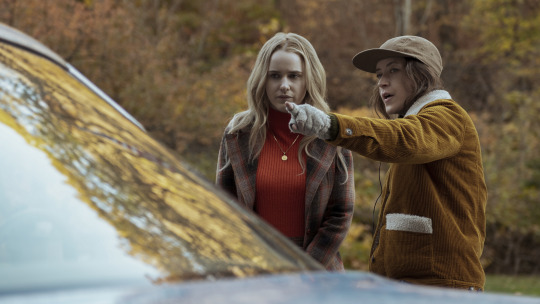
Rachel Brosnahan with director and co-writer Julia Hart.
When you examine Hart’s filmography, it’s impressive how productive she’s been in such a short time, releasing four films within five years, with those pre-schoolers under foot. Horowitz makes a comparison to a prolific filmmaker like Steven Soderbergh, who advises to “fail as fast as you can”. Horowitz acknowledges that “I don’t think we set out like, ‘we’re gonna have two children and we’re gonna make four films in five years.’ If we knew that we were gonna do that we would’ve said, ‘wow, that’s a little bit insane, maybe we shouldn’t do that!’” But they did, and the film world is richer for it.
We always like to ask about the film that made filmmakers want to become filmmakers, and Hart lands on All That Jazz. “I’ve always been a fan of Bob Fosse since his [early] work. How he turned moving your body in a way that people haven’t really moved their bodies before into an empire is very inspiring. [Roy Scheider] is also my favorite actor, which doesn’t hurt. He’s so good.” Horowitz, meanwhile, is a huge fan of Back to the Future. “That was the movie when I was a kid that just opened my eyes to the power of movies, to make you obsess and dream about what other movies could be.”
“I remember going with my parents to see Back to the Future Part II on the Friday night it opened and when we got there it was sold out. We saw some other movie, but I was so upset so all I was thinking about was Back to the Future Part II. As we were leaving the movie theater, I saw through the back little window of the screen where Back to the Future Part II was playing and watched the end scene where Marty is standing in the rain and someone comes and gives him a letter. I did not sleep the entire night. That feeling of anticipation and imagination defines the way I like to look at movies and the way they can make me feel.” A subsequent look at Horowitz’s Letterboxd diary reveals that this conversation perhaps inspired him to take a trip back in time the following day.
Related content
Jordan Horowitz’s list of research for I’m Your Woman
She did THAT!—A list of women who kill
Mothers, Mommy Issues, Moms, Matriarch, Grandmothers
Letterboxd’s Top 200 Crime Films
Disillusionment in Sun-drenched 1970s American New Wave Cinema
Follow Jack on Letterboxd
‘I’m your Woman’ is on Amazon Prime Video now.
#julia hart#jordan horowitz#i'm your woman#rachel brosnahan#crime film#crime thriller#gangster film#gangster's moll#marvelous mrs maisel#directed by women#female director#52 films by women#jack moulton#letterboxd#filmmaking
13 notes
·
View notes
Text
Did The Dark Knight Really Influence the Marvel Cinematic Universe?
https://ift.tt/2QyP40k
In 2008, there were two seismic events in the superhero movie genre so close together that you’d be forgiven for thinking they signaled the same thing. Over the span of a few months, Marvel Studios launched the Marvel Cinematic Universe (MCU) via Iron Man, and director Christopher Nolan changed the perception of how seriously to take these movies with The Dark Knight. Both are credited as watershed moments for how audiences and (more importantly) the industry approached such stories; and The Dark Knight is specifically singled out as the gold standard by which all other masked crimefighter films are measured.
However, was Nolan’s haunting vision—one in which a lone avenger is the last, best hope for a major American city on the verge of collapse—really that influential on its genre? The Dark Knight certainly had a monumental impact on the culture, then and now. You saw it when Heath Ledger’s searing interpretation of the Joker made him only the second actor to win a posthumous Oscar, as well as when the film’s exclusion from the Best Picture race changed the way the Academy Awards handled its top prize. And just last year, The Dark Knight became only the second superhero movie inducted into the National Film Registry.
Yet when a friend watching last week’s The Falcon and the Winter Soldier premiere told me Marvel was returning to the “realistic” approach of Captain America: The Winter Soldier, and by extension The Dark Knight, I couldn’t help but disagree. The new Disney+ series may have a slightly more grounded aesthetic than the last time we saw these characters (back when they were fighting space aliens over magic stones in Avengers: Endgame), but the medium-blending existence of the series belies the idea that Marvel took anything significant from the insular and self-contained Dark Knight Trilogy.
The Dark Knight vs. Iron Man
It’s interesting to look back at just those 2008 films since at face value they bore minor similarities. They both were focused on fantastically wealthy billionaires using their fortunes to fight wrongdoing on a potentially global scale; each movie was directed by filmmakers with indie cred thanks to Nolan helming Memento (2000) and Jon Favreau writing and starring in Swingers (1996); and each starred unexpected casting choices with Ledger as the Joker and Robert Downey Jr. jumpstarting a career comeback as Tony Stark.
But their goals and approaches were worlds apart. The obvious thing to note, besides The Dark Knight being a sequel to Batman Begins (2005) and Iron Man being an origin movie, is that Iron Man had an slyly hilarious sensibility, and The Dark Knight fancied itself an allegory about post-9/11 America. The former’s success was engineered in large part by Downey’s gift for comedic improvisation and freestyle. Indeed, co-star Jeff Bridges said in 2009 that he, Downey, and Favreau were essentially improvising their scenes from scratch every day during primitive rehearsals. “They had no script, man,” Bridges lightly complained with his Dude diction.
By contrast, The Dark Knight appears at a glance to be an exercise in self-seriousness and lofty ambition. Every scene, written by Nolan and his brother Jonathan Nolan, appears like a chess move, and each character a pawn or knight who’s been positioned to put contemporary audiences in a state of pure anxiety with War on Terror imagery and dialogue. Of course this clocklike presentation is itself another Nolan illusion, as smaller players like Michael Jai White, who portrayed gangster Gambol in the movie, have been quite candid about. As with almost every film, there is still a level of fluidity and workshopping on Nolan’s set.
Ultimately, the bigger difference between the Nolan and eventual Marvel approach is what each is hoping to accomplish with the film they’re currently making. More than just offering a “realistic” vision of Batman, The Dark Knight attempted to tell a sweeping crime drama epic that would stand alone, separate from its status as a Batman Begins sequel. Rather than being “the next chapter,” The Dark Knight was meant to be a cinematic distillation of Batman and Joker’s primal appeals writ large. With this approach, the film also broke away from the superhero movie template Batman Begins followed three years earlier, and which nearly all superhero films still walk through the paces of.
In essence, The Dark Knight showed that superhero movies could be dark and mature, yes, but they can also be subversive, unexpected, and genuinely surprising. Nolan’s previous superhero movie, as good as it is, followed the beats set down by Richard Donner’s Superman: The Movie nearly 30 years earlier. They’re the same beats trod by Iron Man and pretty much every other superhero origin movie, including a large bulk of Marvel Studios’ output. The Dark Knight, by contrast, reached for a cinematic vernacular separate from its specific genre. The movie’s not subtle about it either. The opening scene of Nolan’s epic wears its homages to Michael Mann’s Heat on its sleeves, and the story’s structure has more to do with Jaws than Jor-El.
The approach shook audiences in 2008 after they’d come to expect a certain type of movie from masked do-gooders. In The Dark Knight, superhero conventions could be subverted or obliterated when love interest Rachel Dawes is brutally killed off mid-sentence, or stalwart Batman is forced to claim a pyrrhic victory over the villain by entering into a criminal conspiracy and cover-up with the cops. The thrill of novelty was as breathtaking as the movie’s allegorical elements about a society on edge.
And even with The Dark Knight’s open-ended finale, it stood as a singular cinematic experience, complete with then-groundbreaking emphasis on IMAX photography. Nolan was so adamant about making this as self-contained an experience as possible that he jettisoned his co-story creator David Goyer’s idea of setting up Harvey Dent’s fall from grace for a third movie. Dent’s fate, as that of everyone else’s, would be tied strictly to the events of the movie you’re now watching.
“We Have a Hulk”
In Iron Man, and then more forcefully in Iron Man 2 (2010) and the rest of its “Phase One” era, Marvel Studios demonstrated a wholly different set of priorities. Similar to how Batman Begins paved the way for Nolan to do what he really wanted with that material, Iron Man 2 came to encapsulate Marvel Studios President Kevin Feige’s grander designs for the type of movies he was making. Where The Dark Knight was singular, unconventional, and two steps closer to our world than its comic book origins, Iron Man 2 was episodic, entirely crafted around audience expectations for a sequel, and even more like a comic book world than our own.
In other words, the first Iron Man gently submerged audiences into the fantasy by beginning with contemporary images of Tony Stark in a Middle Eastern desert; Iron Man 2 then made sweeping strides in defining what that MCU fantasy is as quickly as possible: Natasha Romanoff, aka Black Widow (Scarlett Johansson) is introduced solely to establish the superspy who will be vital to The Avengers two years down the road, and the central narrative about Tony Stark fighting an old rival is put on pause to reintroduce the character Nick Fury (Samuel L. Jackson) as a supporting, and superfluous, side character. The post-credit scene even arbitrarily introduces literal magic with a glowing hammer that has absolutely nothing to do with the story you just watched. Still, it’s a hell of a teaser for Thor which was due in theaters a year later.
With the release of Iron Man 2, Marvel Studios’ emphasis became diametrically opposed to the driving concept behind The Dark Knight Trilogy. Rather than each film being an insulated, standalone cinematic experience like the Hollywood epics of old, Marvel’s movies would be interconnected episodes in an ongoing narrative saga that spanned multiple franchises and countless sequels. This isn’t necessarily a bad thing. Unlike Nolan after The Dark Knight, Feige and his stable of writers always know where the next movie (or five) is going, and have a better idea of what the overall vision is than any single director working within this system. Ironically, this returns power to the studio and producer as the seeming authorial voice of each movie. Like in the Golden Age of Hollywood, directors are more often hired hands than influential auteurs.
However, this means the aspects Nolan really valued on The Dark Knight beyond a gritty “realism”—elements like spontaneity, subversion, and a distancing from superhero tropes—became antithetical to the type of movies produced by the MCU. For at least the first decade of its existence, the Marvel Cinematic Universe flourished by creating a formula and house style that is as predictable for audiences as the contents in a Big Mac.
When you go to a Marvel movie, you more or less you’ll get: an ironic, self-deprecating tone, a story that often revolves around a CG MacGuffin that must be taken from the villain, and a narrative in which disparate heroic characters come together after some amusing, disagreeable banter. In fact, more than Iron Man, it was Joss Whedon’s The Avengers (2012) which refined the Marvel formula into what it is today.
There are of course exceptions to this rule. Black Panther became the first Marvel movie since Iron Man to arguably tackle themes significant to the real world, in this case specifically the legacy of African diaspora. It also became the first superhero film nominated for an Oscar for Best Picture as a result; James Gunn’s Guardians of the Galaxy movies might follow the narrative formula of most MCU movies, but they’re embedded with a cheeky and idiosyncratic personality that is distinctly Gunn’s; and in Captain America: The Winter Soldier (2014) and Captain America: Civil War (2016), directors Joe and Anthony Russo, as well as screenwriters Christopher Markus and Stephen McFeely, attempted to inject a little bit of that “realistic” aesthetic from The Dark Knight. But only to a point.
Particularly in the 2014 effort, there was a push by the Russos to rely on in-camera special effects and cultivate what they often described in the press as a “1970s spy thriller” style. Ostensibly, the hope may have been to make The Winter Soldier as much a spy thriller as The Dark Knight was a crime epic. In this vein, there were even attempts to graft onto the story very timely concerns about the overreach of a government surveillance state, which had only grown in the decade since the U.S. PATRIOT Act was passed, despite a change in White House administrations. However, all of these ambitions had an invisible ceiling hovering above them.
Despite having overtones about the danger of reactionary if well-intentioned government leaders, like the kind personified by Robert Redford’s SHIELD director in the movie, Captain America: The Winter Soldier couldn’t become too focused on the espionage elements or too far removed from the Marvel house style. The story still needed to interconnect with other Marvel films, hence Redford’s character turning out to be a secret HYDRA double agent, and it still needed to give audiences what they expected from a Marvel movie. Thus how this “1970s spy thriller” ends in a giant CGI battle with citywide destruction as Captain America inserts MacGuffins into machines that will blow up HYDRA’s latest weapon for world domination.
It’s easy to wonder if the movie was developed a little longer, and didn’t have to play by a certain set of rules and expectations, that instead of backpedaling into comic book motivations, Redford’s character would’ve been a well-intentioned patriot amassing power “to keep us safe,” and in the process destabilized the institutions he claimed to revere.
Read more
Movies
What Did Batman Do Between The Dark Knight and The Dark Knight Rises?
By David Crow
TV
WandaVision: The Unanswered Questions From the Marvel Series
By Gavin Jasper
A Universe Without End
The Marvel method breeds a heavy need for familiarity and comfortable predictability, as opposed to disorientation and discomfort. Yet both methods are valid. While Nolan achieved near universal praise for The Dark Knight, his attempt to replicate it with the even more ambitious The Dark Knight Rises—an unabashed David Lean-inspired epic that took more from A Tale of Two Cities and Doctor Zhivago than DC Comics—left fans divided. It also was a narrative dead end for the corporate/fanbase need of an ongoing franchise. Nolan instead reached a final, artistic, and emphatic period for his cinematic interpretation of Batman mythology. By comparison, Marvel Studios has created a new cinematic vernacular that only ever uses dashes, semicolons, and commas. There is always more to tell.
Nolan reflected on these changing circumstances for superhero movies in 2017 when he said, “That’s a privilege and a luxury that filmmakers aren’t afforded anymore. I think it was the last time that anyone was able to say to a studio, ‘I might do another one, but it will be four years.’ There’s too much pressure on release schedules to let people do that now, but creatively it’s a huge advantage.”
This lines up with what Jeff Bridges said about the evolution of the Marvel method way back in ’09 after the first Iron Man: “You would think with a $200 million movie you’d have the shit together, but it was just the opposite. And the reason for that is because they get ahead of themselves. They have a release date before the script [and they think], ‘Oh, we’ll have the script before that time,’ and they don’t have their shit together.”
Bridges’ unhappiness with the new process notwithstanding, Marvel was rewriting the playbook about how these types of movies were made. Nolan’s approach of one at a time and years-long development processes created three distinctly different and relatively standalone Batman movies. But Marvel has shifted the idea of not just what a franchise can be, but also what cinematic storytelling means.
Instead of three movies, their rules and structures have generated dozens of well-received and adored entertainments, that when combined can produce experiences as unique as Avengers: Infinity War (2018) and Avengers: Endgame (2019): two movies that were more like a two-part season finale on TV than individual stories. And the latter became the highest grossing film of all time.
The success of this approach is further underlined when one considers competitors that tried to emulate both Marvel and Nolan’s approaches, relying on a lone auteur to build a shared cinematic universe—while also arguably taking the wrong lessons from the “dark” in The Dark Knight title. In the case of the DC Extended Universe, that approach collapsed on itself after three movies, leaving the interconnected “shared” part of its universe in tatters, and fans and studio hands alike divided on how to proceed with the franchise.The Marvel Cinematic Universe took a narrower road than that of The Dark Knight. But it turned out to be a lot smoother and much, much longer.
cnx.cmd.push(function() { cnx({ playerId: "106e33c0-3911-473c-b599-b1426db57530", }).render("0270c398a82f44f49c23c16122516796"); });
The post Did The Dark Knight Really Influence the Marvel Cinematic Universe? appeared first on Den of Geek.
from Den of Geek https://ift.tt/3lKi0hp
2 notes
·
View notes
Text
Scoot McNairy On Lightening Up In HBO Max’s ‘Love Life’ And The Making Of A Great ‘Narcos: Mexico’ Scene
By Kimberly Ricci
The first few times I interviewed Scoot McNairy, I got a little aggressive with rampant questions about his righteous mustaches. In my defense, these discussions of facial hair often lightened the mood as we discussed his recent heavy roles on True Detective‘s third season and the most recent round of Narcos: Mexico. Scoot’s always a good sport about answering the most bizarre of inquiries, but for his latest project — an HBO Max dramedy, Love Life, starring Anna Kendrick — no such lightening was required.
Don’t get me wrong, it’s not that there isn’t a mustache present with this Scoot project. There is one, although it’s not as plentiful as those that he sported in the above two projects and Godless. So, the Halt and Catch Fire actor was off the hook (this time) for any facial hair talk. Fortunately, he’s still gracious enough to discuss this latest role (a wealthy entrepreneur and slightly older man who plays a key role in helping Kendrick’s character develop) with us, including how much of a relief it is to step into the shoes of a less-stressed-out character. I also wished to discuss the latest Narcos: Mexico season finale, which ended with a fantastic, fictionalized, and quiet confrontation between his DEA agent character, Walt Breslin, and the drug lord (portrayed by Diego Luna) that he put behind bars, and Scoot was game for that, too.
Love Life is a nice piece of an escapism. Would you characterize it as a romantic comedy or dramedy?
I haven’t seen the project as of yet, but after reading and talking with [showrunner] Sam Boyd, it feels like it’s more of a dramedy, and also a sort-of slice-of-life over the course of ten years, well, basically a decade.
Even though it’s not 100% cheery, this role’s definitely more lighthearted than anything you’ve done lately. Did that feel like taking a load off?
You know, it was a lot of fun. I started in this business twenty years ago, and for the first ten years, mostly what I did was comedy, and I haven’t been able to do that in eight or nine years. So, I was really looking to try and find something to do, comedic-wise, and Sam had this project that I really liked. So yeah, I really enjoy doing comedy or dark comedy, so this was really fun to step back into that — a lighter role.
Whenever I think about artists switching up genres and entering different phases, I think of an old Ethan Hawke interview, where he expressed his surprise at how shooting horror movies was a lot more silly and less terrifying than he expected. Was making a romantic comedy the same or different than you expected?
That’s a really great question, but you know, it just felt familiar. Comedy is something that I’m somewhat uncomfortable with but obviously very, very scared of and stuff, and it’s also about challenging yourself with something that you haven’t really done in a long time and something you really enjoy doing. And also just moving around, switching it up, and trying not to get pigeonholed into a sort-of genre, just to stretch your wings, I guess.
I don’t know if you’re aware, but one of the Love Life promo shots zeroes in on your character, Bradley, with a martini. You’re playing a character who drinks martinis!
Yeah! He’s a New Yorker, really into art and very motivated and ambitious. That being said, there’s also a lighter side to the character. I just hadn’t done comedy in so long, so I was really itching to do it. And Anna Kendrick is genius, and incredible at what she does, and I was really looking to work with her on something that was comedic and in her wheelhouse. She’s incredible in this, and it’s such an amazing project for her and role for her, so I was really excited to just be a part of that.
And the writing feels realistic and without too much reliance upon clichés.
Sam Boyd, the creator, he’s a really really smart guy. He was incredibly great to work with and collaborative and all that, but he wrote an incredible story. Really heartfelt and funny and sad at times, so I think it should be a really fun, wild ride.
Do you have a favorite romantic comedy?
Some of the older ones like When Harry Met Sally and Richard Linklater’s earlier stuff, including Before Sunrise. I loved those movies and the big, broad comedies like the Will Ferrell stuff.
Producer Paul Feig’s helming of Bridesmaids might bring a lot of curious eyes to this project. There are some similarities.
Yeah, definitely, I hope so. It’s really special and unique and also brings us back to movies like Reality Bites. It’s kind-of like a version of that for the newer generation.
That newer generation has been embracing romcoms on Netflix. Do you have any take on why those movies are doing so well there?
I don’t, to be honest, I didn’t know that. But as of right now, in the position where people are in quarantine, romcoms are movies that make you feel good, so maybe we’re seeing a lot of that just because of the times we’re going through.
Talking about your Love Life character any more would lead to spoilers, so do you mind if I ask you about the Narcos: Mexico season finale?
Nope. You mean the one we last finished?
Yes, and specifically, the conversation between Walt Breslin and Félix Gallardo. I’ve been comparing it to other great confrontations like Pacino and De Niro in Heat and FX’s Justified ending.
Wow.
Did you draw inspiration from any movies or TV shows, or was it solely about those two characters to you?
Oh, I was terrified to do that scene, to be honest to you. A lot of what you’re seeing is just terror, but I know that there’s always, in these sort-of male-driven shows, there’s always this reference back to Heat. You know, Carlo Bernard, one of the creators of the show, he worked with Michael Mann and actually worked on Heat, so we’re always throwing that around and stuff, so yeah, in so many ways, it’s going to resemble that scene. But I don’t speak Spanish, and that whole scene was in Spanish. It was a long one, so I am very glad to hear you say that it turned out so great because it was a very nervous one for me.
Aren’t you a Texas native? I grew up in Oklahoma, and Spanish wasn’t required but strongly encouraged. I can’t imagine going into that scene dry.
I learned a little bit in the time that I had, but even as a kid, I never picked up much Spanish living in Texas.
So when you think about Walt and Félix, do you sense any admiration there as well as contempt? Or was I reading too much into that?
Oh for sure! You develop, in law enforcement, when you’re going after a case for X amount of time, I’m sure you develop a relationship with that person, and you know so much about them that there is a sense of admiration and respect when you’ve kind-of got your guy. The very thing I think about that scene is that, like, there’s this idea that Walt got his guy, and he’s won. And throughout that scene, he [realizes] that’s he’s only created a worse problem. And I love the sort-of dynamics that shift in that scene. And him going through what is to come because of what [he’s] done. Like, [he] didn’t do anything but cause a worse problem.
And on a personal level, Walt didn’t even get the closure that he wanted.
Yeah, neither one of them. It feels like they both lost.
Have you heard anything about another season?
No, I would gladly be open to doing more. I had a wonderful time on the show and loved working with the crew down there and all the people on the show, executives and Netflix. It was a dream job, so I would happily jump back down there.
The first three episodes of ‘Love Life’ premiere on May 27 with the launch of HBO Max.
[x]
6 notes
·
View notes
Text
Blu-ray Review: The Omen Collection
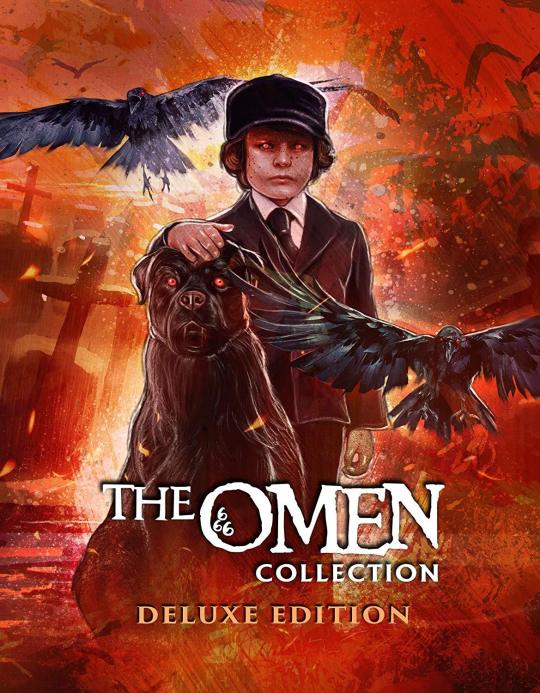
In the pantheon of religious horror, the holy trinity consists of The Exorcist, Rosemary's Baby, and The Omen. Although The Omen arrived last, opening on June 6, 1976, it arguably offers more excitement than its satanic brethren (which is not to say that it is a superior film). Likely to be considered a slow-burner by today's standards, the picture builds tension and unravels a mystery at a meticulous pace, but it's punctuated by elaborate, Rube Goldberg-ian death scenes.
The Omen spawned a trilogy of films, a made-for-television sequel, and a modern remake. Scream Factory has collected all five movies in The Omen Collection, which is limited to 10,000 units. Besting Fox's earlier Blu-ray set - which omitted Part IV and featured some of the worst box set packaging known to man - each film is packaged in an individual Blu-ray case with original artwork within a rigid slipcover case. It boasts a deluge of extras, new and old.

In the original film, American diplomat Robert Thorn (Gregory Peck, To Kill a Mockingbird) and his wife, Katherine (Lee Remick, Anatomy of a Murder), adopt a baby named Damien (Harvey Stephens) after their own child is stillborn. Beginning with his fifth birthday, a string of mysterious deaths surround Damien. Upon being presented with convincing evidence by a photographer (David Warner, Tron), Robert becomes convinced that his son is none other than the antichrist, and he is faced with the task of stopping him to prevent Armageddon.
Firing on all cylinders, The Omen is an exemplary horror film. Working from a well-constructed script by David Seltzer (Shining Through, Prophecy), director Richard Donner grounds the story firmly in reality. The fantastical elements are easy to swallow, as each and every incident in the plot could be mere coincidence. Peck brings a gravitas to the production, leading a strong cast in which Remick also holds her own. Even the six-year-old Stephens, who never acted before and did very little after, is convincingly malevolent.
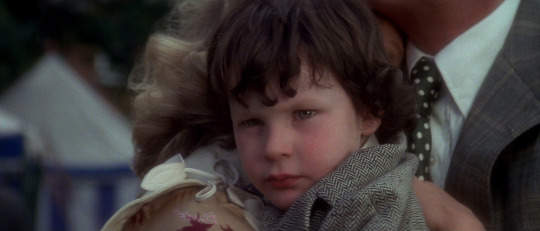
John Richardson's (Aliens, Harry Potter) special effects for the proto-Final Destination deaths - including one of the greatest beheadings ever committed on celluloid - remain shocking after more than 40 years. Cinematographer Gilbert Taylor (Star Wars: A New Hope, Dr. Strangelove) captures it all with clean camerawork, while Jerry Goldsmith (Alien, Gremlins) provides a chilling orchestral score elevated to pure evil with choral chanting.
The Omen has been newly mastered in 4K from the original negative, approved by Donner, for the new release. The result is a pristine presentation with improved detail and color saturation over Fox’s previous high-definition transfer. The Omen carries a whopping four audio commentaries. One, featuring special project consultant Scott Michael Bosco, is new. His audio sounds compressed - as if it were recorded on a cell phone - but it's dense with details focusing on the theological aspects. Bosco often digresses, but I appreciate the fresh perspective rather than a historian reciting IMDb trivia.
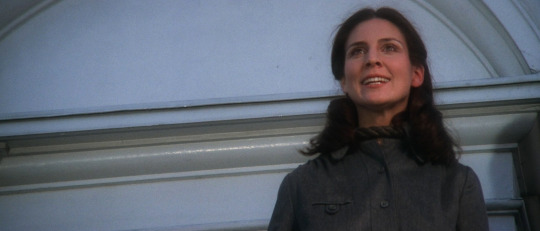
The other audio commentaries include: a track with Donner and editor Stuart Baird (Lethal Weapon, Skyfall), in which the two old friends reminisce about the highs and lows of the production; a track with Donner and filmmaker Brian Helgeland (Mystic River, L.A. Confidential), which features as much good-natured joking as it does insight; and a track with film historians Lem Dobbs, Nick Redman, and Jeff Bond, largely focusing on Goldsmith's score. A lot of information is repeated across the commentaries, but the varying viewpoints make them all worth listening to.
Seltzer and actress Holly Palance (who plays the nanny whose suicide by hanging is among the film’s most memorable moment) sit down for new interviews. Seltzer's chat is particularly enjoyable, as he's candid and humble. He openly states that his script is not as good as the movie it birthed. He also shares what he would have done if he had the opportunity to write the sequel. Palance, the daughter of the great Jack Palance, recounts her naivety about working on her first film and shooting her iconic death scene. The final new extra is an appreciation of The Omen's score by composer Chris Young, who says he looked to Goldsmith's progression across The Omen trilogy as he was scoring the Hellraiser films. It's fascinating to hear one accomplished professional praise another in their field.

All of the archival extras are ported over: a thorough, 15-minute interview with Donner from 2008; 666: The Omen Revealed, a 46-minute retrospective from 2000 featuring crew members along with religious experts to provide context; The Omen Revelations, which is essentially a streamlined version of 666, recycling much of its footage in 24 minutes; Curse or Coincidence, in which the crew recounts a variety of curious incidents that nearly derailed the production; an introduction by Donner; a deleted scene with commentary by Donner; an older interview with Seltzer, which features a lot of the same information as the new one; and an interview with Goldsmith about his score.
There's also an appreciation of The Omen by filmmaker Wes Craven (A Nightmare on Elm Street), in which the master of horror waxes poetic about the influential picture for 20 minutes; Trailers from Hell trailer commentary by filmmaker Larry Cohen (The Stuff), who cites The Omen as one of his favorite movies; the trailer; TV spots; radio spots; and four image galleries: stills, behind-the-scenes, posters and lobby cards, and publicity.
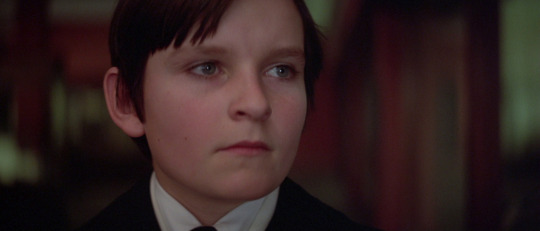
Following the massive success of the first film, Fox fast-tracked a sequel, Damien: Omen II, to open in 1978. Having narrowly survived the events of The Omen, a 12-year-old Damien (Jonathan Scott-Taylor) now lives with his affluent uncle, Richard Thorn (William Holden, Sunset Blvd.), aunt, Ann (Lee Grant, In the Heat of the Night), and cousin, Mark (Lucas Donat), in Chicago. Damien is ostensibly a well-adjusted kid, unaware of who - or what - he is, but those who cross him wind up dead in freak accidents.
Omen II's plotting mirrors that of the first film, but the mystery aspect that made the original so effective is gone. The viewer knows from the start that Damien is, in fact, the antichrist, so they're left waiting for the characters to catch up. The plot dedicates an inordinate amount of time to Thorn's business enterprises, which is only vaguely paid of in the next installment when Damien rises to power. On the bright side, there are several admirably inventive deaths in the tradition of the first, from a bird attack that would make Alfred Hitchcock jealous to a visceral elevator bisection to a harrowing scene of a man trapped in a pond under ice.
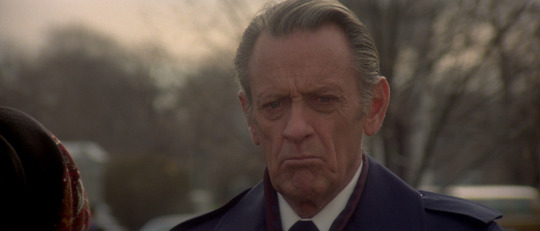
Since Donner had moved on to Superman and Seltzer was either uninterested or not asked (depending on the source) to pen the sequel, a new creative team was employed. Stanley Mann (Firestarter, Conan the Destroyer) and Mike Hodges (Get Carter, Flash Gordon) wrote the script, with the latter set to direct. Hodges only shot for a few days, during which he quickly fell behind schedule, before being swiftly replaced by Don Taylor (Escape from the Planet of the Apes). Goldsmith returns to score with a worthy successor, retaining the signature sound while expanding it to incorporate electronics.
Leo McKern is the only returning cast member, reprising his role as archaeologist Carl Bugenhagen in the prologue. Peck's formidable presence is sorely missed, but Holden - who, incidentally, turned down the lead role in The Omen - and Grant bring some prestige to the production. Scott-Taylor is a convincing surrogate for Stephens, but the child acting leaves a bit to be desired. It's offset by a supporting cast that includes Lance Henriksen (Aliens), Lew Ayres (All Quiet on the Western Front), Sylvia Sidney (Beetlejuice), Allan Arbus (M*A*S*H), and Meshach Taylor (Mannequin).
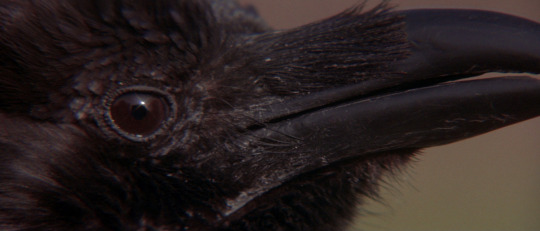
Damien: Omen II's Blu-ray disc features new interviews with Grant, who is proud of the sequel and shares a funny anecdote about discovering her first wrinkle while filming; Foxworth, who was able to get to know Holden, one of his heroes, on their daily commute; and actress Elizabeth Sheppard, who proudly discusses working with Holden as well as Vincent Price (on The Tomb of Ligeia). In a separate featurette, Sheppard narrates a gallery of her personal photos from the shoot, offering a behind-the-scenes look at the bird attack sequence.
Since Omen II's mythology has little biblical foundation, Bosco's new commentary features even more tenuous tangents, but it affords him the opportunity to discuss the franchise more subjectively. An archival commentary with producer Harvey Bernhard proves to be a bit more informative. The disc also includes a vintage making-of featurette consisting of clips, interviews, and footage from the set, along with the trailer, a TV spot, a radio spot, and a still gallery.
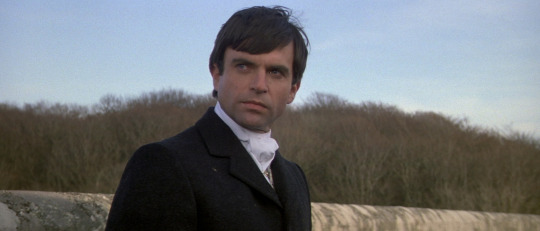
The Omen trilogy came to a conclusion in 1981 with Omen III: The Final Conflict - although it proved not to be final after all. As prophesied, Damien (Sam Neill, Jurassic Park), now 33 - the same age as Jesus when he was crucified - has risen to political power. Following the U.S. ambassador to Great Britain’s ghastly suicide, Damien is appointed the position, which was once held by his adoptive father. The only true foe for the antichrist is, naturally, Christ himself. Rather than bringing about the apocalypse, as the franchise had been driving toward since the beginning, Damien attempts to prevent the second coming in a sanctimonious conclusion to the story arc.
While no successor could top the original Omen, its first sequel smartly embraced the gratuitous death scenes. For the third installment, however, director Graham Baker (Alien Nation) made a conscious effort to avoid them. Instead, he delivers inept monks trying to assassinate Damien with the Seven Daggers of Megiddo, while the antichrist’s legion of apostles murder newborn males who are the potential Christ child. Andrew Birkin's (Perfume: The Story of a Murderer) script leans further into religiosity at the expensive of the horror elements while interjecting silly mythology akin to Halloween: The Curse of Michael Myers.
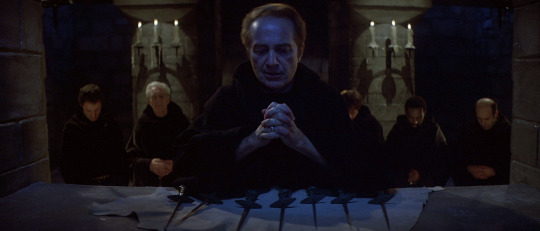
Omen III: The Final Conflict's Blu-ray disc features new interviews with Baker, who takes a truly retrospective look back on the film, comparing the society of today to that of when it was produced; Birkin, who hadn't seen The Omen when he first met for the gig and wasn't particularly impressed when he finally watched it; and production assistant Jeanne Ferber, who explains how she was among those polled by Bernhard to help choose the lead, with Neill selected unanimously.
For his final commentary in the set, Bosco is back to pointing out the film's connections to scripture, leading to a lengthy tirade comparing Christianity and Judaism. An archival track with Baker has a few nuggets of information among extended gaps of silence, but most of his points are addressed more concisely in the new interview. Special features are rounded out by the trailer, TV spots, and a still gallery.
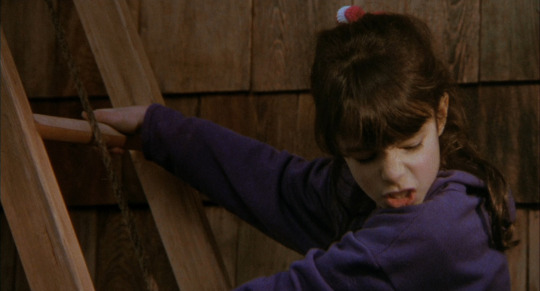
Although The Omen’s main storyline continued with two more book sequels, Fox opted to use the familiar title for a made-for-television movie on their budding network in 1991. Although dubbed Omen IV: The Awakening, the film largely serves as a remake of the original film but with a female antichrist. After numerous failed attempts to get pregnant, politician Gene York (Michael Woods) and his wife, Karen (Faye Grant, V), adopt an orphan girl. Seven years later, Delia (Asia Vieira, A Home at the End of the World) becomes increasingly violent and manipulative, leaving a trail of bodies in her wake.
Similar to Omen II's production troubles, Omen IV started with Jorge Montesi (Turbulence 3: Heavy Metal) in the director's chair, but he was fire mid-shoot and replaced by Dominique Othenin-Girard (Halloween 5: The Revenge of Michael Myers). Writer Brian Taggert (Poltergeist III) keeps the basic structure of Seltzer's original script intact, but the details of each beat are altered and the death scenes are subdued for TV. In addition to gender-swapping the creepy kid, it's the mother who is proactive this time around.
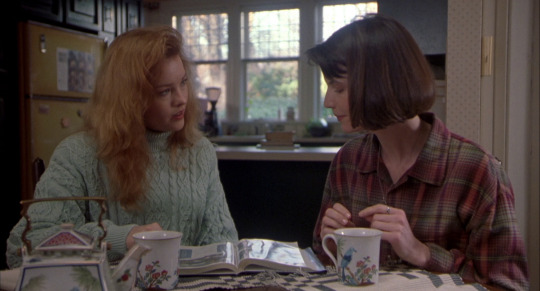
Despite maintaining the general outline of The Omen, the plot is harder to believe this time around, stretching the required suspension of disbelief to include psychics that can read auras. The most ludicrous plot point comes in the form of a shoehorned connection to The Omen mythology. This "twist" canonically positions Omen IV as a sequel rather than a thinly-veiled remake, but it feels more like a low-budget knockoff than an official installment in the franchise.
Omen IV: The Awakening doesn't have any audio commentaries, but its Blu-ray debut includes a new interview with Taggert, who breaks down several of the major choices made in the script. It also contains The Omen Legacy, a feature-length documentary on the franchise that aired on TV in 2001. Narrated by Jack Palance (City Slickers), it finds cast and crew members (including a couple of folks who don't appear in any other special features) and religious figures (the Church of Satan’s high priestess among them) discussing all four films while playing up the alleged curse. The trailer and a still gallery are also included.
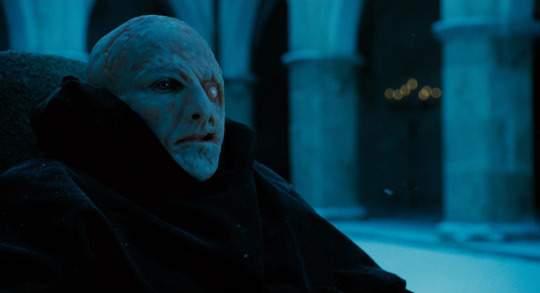
Amidst the onslaught of horror remakes that dominated the early 2000s, Fox shrewdly capitalized with The Omen in 2006 - on 6/6/06, to be exact. Director John Moore (Max Payne) offers slick production value and an inspired cast, but it feels wholly unnecessary considering how closely it follows the original script. Seltzer is the only credited writer, but it's unclear if his 40-year-old script was simply polished off or if he was involved in re-writes, as there are some subtle changes to contemporize it. While it fails to bring anything new to the table, it’s a stronger effort than Omen IV.
Liev Schreiber (Scream) and Julia Stiles (10 Things I Hate About You) star as the Thorns. Talented as they are, they lack the chemistry of Peck and Remick. Seamus Davey-Fitzpatrick is successfully creepy as the new Damien, while the role's originator, Harvey Stephens, makes a quick cameo. In a particularly motivated bit of stunt casting, Mia Farrow (Rosemary's Baby) plays the antichrist's new nanny. David Thewlis (Harry Potter) and Pete Postlethwaite (The Lost World: Jurassic Park) also have supporting roles.
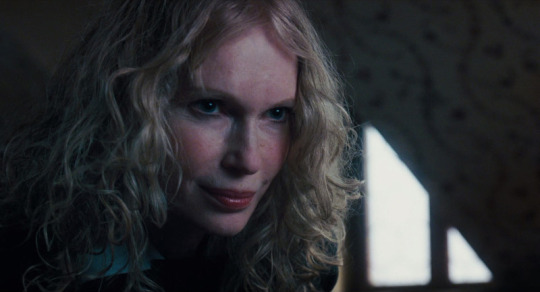
The remake is the only Blu-ray in the set that doesn't offer any new special features. The existing extras cover a lot of ground, but it would’ve been interesting to hear the crew reflect back on it. Omenisms is a 37-minute documentary exploring the pressures of making a movie with a release date set in advance, even showing Moore losing his temper and yelling at a producer. It feels very of its time, with director Stephen French treating the piece like a hip art film, but it contains a lot of great material.
Moore, producer Glenn Williamson, and editor Dan Zimmermann participate in an audio commentary that's fairly informative but doesn't touch on many of the trials and tribulations showcased in Omenisms. There's also a featurette about Marco Beltrami (Scream) recording his score at the legendary Abbey Road Studio; Revelation 666, a cheesy TV special tracing the history, interpretation, and theories of 666; unrated, extended scenes, including a longer version of the ending; and theatrical trailers.
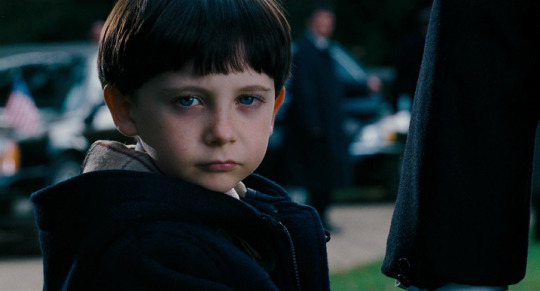
While The Exorcist remains the be-all and end-all of occult horror, The Omen franchise as a whole is more consistent. The first three Omen films comprise a cohesive trilogy, while Part IV and the remake each offer a fresh, if flawed, perspective on the material. Between the movies, commentaries, interviews, and featurettes, The Omen Collection contains over 30 hours of content, making it an unbelievable value and a must-have for any horror collector.
The Omen Collection is available now on Blu-ray via Scream Factory.
#the omen#gregory peck#damien: omen ii#omen iii: the final conflict#omen iv: the awakening#mia farrow#scream factory#dvd#gift#review#article#damien thorn#liev schreiber#julia stiles#lance henriksen#lee remick#william holden
30 notes
·
View notes
Audio
Exclusive Track & Interview: 28 Days Later composer John Murphy’s “Les Misérables”
Check out this exclusive premiere of John Murphy's "Les Misérables" from the BBC/PBS's Masterpiece Les Misérables now. This version is very close to Victor Hugo's original novel, and hence is not a musical. The soundtrack will be available May 3.' Murphy also dishes on the challenges of scoring such a huge, epic, and sweeping story (and a lot more) in the interview below.
Exclusive premiere: John Murphy's "Les Misérables" from Masterpiece's Les Misérables
Lakeshore Records is set to release the original soundtrack to the critically-acclaimed BBC/PBS Masterpiece mini-series Les Misérables, written by composer John Murphy (28 Days Later, Sunshine, Kick-Ass). Check out our interview with Murphy and the exclusive song directly below this article. Les Mis the album will be released digitally on May 3 with CD and vinyl versions forthcoming.
This Les Mis is NOT a musical; in fact, it is relatively faithful to the source novel. It premiered April 14 on PBS, but all episodes can be watched with PBS Passport.
Les Misérables is a six-part drama adaptation starring Dominic West (The Affair) as Jean Valjean, and David Oyelowo (Selma) as Javert in this landmark take on a classic, timeless, and sweeping story. They are joined by Lily Collins (Rules Don’t Apply), in the role of Fantine.
With a striking intensity and relevance to us today, Victor Hugo's novel is a testimony to the struggles of France’s underclass and how far they must go to survive. The six-part television adaptation of the renowned book vividly and faithfully brings to life the vibrant and engaging characters, the spectacular and authentic imagery and, above all, the incredible yet accessible story that was Hugo’s lifework.
The distinguished British cast includes Adeel Akhtar (The Night Manager) and Academy Award winner Olivia Colman (The Favourite) as Monsieur and Madame Thénardier, Ellie Bamber (Nocturnal Animals) as Cosette, Josh O'Connor (The Durrells in Corfu) as Marius and Erin Kellyman (Raised By Wolves) as Éponine.
Liverpool born John Murphy began scoring movies at the age of 25. In 2001, following the success of Lock, Stock and Two Smoking Barrels and Snatch, he moved to Los Angeles.
Since then he has worked with some of the industry's most respected and luminary filmmakers, including Danny Boyle, Guy Ritchie, Stephen Frears, Matthew Vaughn and Michael Mann, producing film scores as prominent and diverse as Sunshine, Lock Stock and Two Smoking Barrels, Miami Vice, Snatch, Kick-Ass, and the seminal 28 Days Later.
Murphy's movie trailers include: Captain America: Winter Soldier, Gravity, X-Men: Origins, Cloverfield, War of the Worlds, Cowboys and Aliens, Blindness, Ex Machina, Southpaw, X-Men: Days of Future Past, and Avatar. His music has been featured in advertising campaigns for Nike, Audi, Microsoft, Louis Vuitton, Samsung, Google, and Apple.
After Kick-Ass, Murphy set up the record label Taped Noise and began work on several non-movie projects. BBC/PBS Masterpiece Theatre's Les Misérables is his latest project.
Les Misérables director Tom Shankland wanted John to tell a fresh musical story and to ultimately create a raw and uncompromising score to reflect the trials and misery of "Les Misérables." John describes the scoring process as an "experimental journey."
Initially, Tom wanted a gritty, folk-oriented score, but as they began the process, he and John quickly realized that the story would need a broader musical palette. John ended up incorporating less obvious elements such as bowed electric guitar, analog synths, experimental viola, and backwards loops, with a nod to the classic French romantic scoring of the '60s. Despite mixing instrumentation, the elements fused and the sensibility stayed true throughout.
John described the scoring process further:
"My original idea for the score to Les Mis was '1816 Velvet Underground meets '60s French film music.' While director Tom [Shankland] was thinking 'gnarly, down in the dirt, French folk music.' Producer Chris Carey suggested, 'let's do both, but throw in some vintage analog synths.' I then gleefully tried all of these elements, often at the same time. And we discovered that you can actually mix a hurdy gurdy with a Moog Sub Phatty, and we loved it. And what started out as a musical standoff, became our score for Les Misérables."
Interview: John Murphy
Hello John and welcome!
Hey Wess. Good to talk with you!
Likewise. To start things off, what attracted you to this telling of Les Mis as a project? I really appreciated how it was based on Hugo's novel, and not a musical. The novel, in my opinion, does not get enough praise.
Yeah, sadly the musical has pretty much hijacked this great novel. I read it in my early twenties. I was a session player back then and I spent a lot of time on tour buses, so I got through a lot of reading. Aside from all the ideas and themes, it's a great story – hope, despair, sacrifice, redemption, all the good stuff. I loved it.
I read it when I was in my twenties as well. Such a great novel.
So when the call came in, I did some Skype meetings with the director Tom Shankland and producer Chris Carey, and they were so passionate about it, and so hell-bent on going back to the source, the book I loved. I knew I had to do it.
That's fantastic. I was hoping we could get an idea of your overall creative process on the project. It really is very sweeping in the emotions of the story and the history it covers.
Well I've really only ever done movies so I knew the production process would be different. For example, before they started shooting I had to write a lot of the in-camera music they needed to shoot to; the scene with the band in the pimp's den, Cosette's piano pieces, Gavroche's song when he runs out to collect the bullets, that kind of thing.
Oh wow.
Which was cool because I'd never done that before. And then there was a big break while they filmed and put together the episodes. So rather than sit around and wait, I started sketching out themes and ideas from the script, which is actually way more creative than writing to picture. But having this pot of ideas was a life saver because, when the episodes finally did come, they came thick and fast.
But the actual creative process wasn't too different from scoring a film. I always write the themes first, and I try to write them away from picture. And then I'll work to picture and write the featured cues, the montages, the chases, that kind of thing. And then you're down to the underscore cues and you're just connecting the dots really.
Interesting process John. What were the challenges like?
I think the biggest challenge was time. Even though I had ideas sketched out for most of the themes, there's only so much you can do until they give you locked picture. And when the final locked cuts started coming, I had about 20 days per episode from start to delivery. And this is when I would score everything in, write the underscore, record the soloists, and mix the tracks ready for the dub. There was usually about forty cues and forty minutes of music per episode. So there were a few long nights!
Were there huge differences between Les Mis as a project and working on your more conventional titles like 28 Days Later? You've scored quite a bit in the horror realm.
I've actually only scored a few horror films. They just tend to be the ones people remember!
[Laughs] good point. I was thinking just relative to other composers I've talked to…
Because of the musical, there's kind of a skewed perception of Les Miserables. But a lot of the book is actually very dark. And, for whatever reason, I find it much easier to work with darker material.
I find myself attracted to darker art as well; not just film.
For me, it's just a deeper well to draw from. So even though it's based upon an historic work I never felt like I was writing outside of my own instincts. At the end of the day, whatever the scale, it all comes down to ideas, story and characters.
Absolutely. Any memorable or funny moments that stick out from that behind the scenes process of scoring the series?
There were, but none I could mention! [Laughs]
[Laughs] fair enough. A question I ask most everybody: what scores and films have molded you most as an artist?
I think the first time I became aware that movies used music was in A Fistful of Dollars. I must have been six or seven and it was on TV one night. I remember thinking why is there music playing? Where is it coming from? After that I started listening for it when I watched movies. So, I think my love for [Ennio] Morricone started there. And after that it was the James Bond movies, and the great John Barry themes. Another film composer I love to this day. I was just a kid, but I remember getting hyped up whenever I heard that guitar riff. A few years later, when I started to play a few things, I discovered Bernard Herrmann.
Psycho always stands out for me when I think of a great score. It may be cliché to say but it is true.
I couldn't fathom how he could make music that was so dark and so beautiful at the same time. I'd never heard anything like it and it blew me away. It was like magic.
So, those three made more of an impression on me than any specific movies. Thinking about it now it's probably why I'm so theme-heavy today. Because those guys definitely knew how to write a theme.
That they did. One other big question which is sort of related, what makes a great score?
That's such a difficult question and I don't think there's a definitive answer. But if it truly moves you and takes you somewhere else, then it's doing something right.
Well said. Last, what's next for you?
Well, Les Mis was like doing six movies back to back, so I won't be jumping into another big project just yet! I'm going to mess around with one of my own projects for a few months and then see what's around. Maybe a cool little indie where I get to play everything myself!
https://www.thefourohfive.com/film/article/exclusive-track-interview-28-days-later-composer-john-murphy-s-les-miserables-155
9 notes
·
View notes
Text
The ThanksgivingWarrior 11/25/20 – THE CROODS: A NEW AGE, MA RAINEY’S BLACK BOTTOM, ZAPPA, HAPPIEST SEASON, STARDUST and More!
It’s Thanksgiving weekend, and usually I’d be struggling to figure out how much the new movies might make in what is normally one of the most unpredictable weekends at the year. Wait a second. I’m getting déjà vu here. Didn’t I say this exact same thing in the intro for last week’s column? Probably. Let’s face it, kids. I am absolutely losing my mind with how bored I am getting looking at my laptop screen all day long, even though I’ve now set up a pretty sweet new TV system to watch stuff on!
Anyway, there is one family movie coming to theatres this weekend, and in any other Thanksgiving weekend, I’d suggesting getting out and going to theaters, but at this point in the pandemic, with COVID numbers so bad that even I, “Mr. Reopen the Movie Theaters!” can’t recommend going to see a movie in theaters… well, except maybe in New York City, where they’re still closed. Sigh.
We’re going to do things a little different this week, because I wasn’t able to get to as many movies as I wanted but didn’t want to delay the column to Thanksgiving Day. Instead, I’ll post what I have done on Wednesday, then check back here on Friday when hopefully I’ve added a few more reviews. Cool?
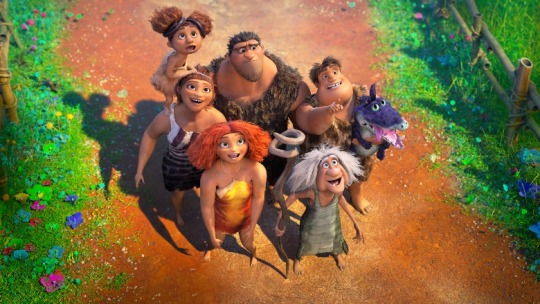
Fortunately, the new animated sequel from DreamWorks Animation and Universal Pictures, THE CROODS: A NEW AGE, is a lot of fun, and this is from someone who really enjoyed the first movie quite a bit. The sequel’s premise is as simple as you can get: caveman family The Croods (voiced by Nick Cage, Catherine Keener, Emma Stone, Clarke Duke and Cloris Leachman), along with Ryan Reynold’s Guy, are still trying to survive in the wilds until they encounter a beautiful oasis that turns out to be the home of the more-evolved Bettermans, Phil (Peter Dinklage), Hope (Leslie Mann) and Dawn (Kelly Marie Tran).
I really liked the original The Croods quite a bit, so I’ve been waiting patiently for DreamWorks to figure things out for a sequel. My instincts were definitely spot-on, because even if the original premise sounded a lot like The Flintstones, putting those voice actors together, even if it’s just Ryan Reynolds and Emma Stone proved to be quite prescient. A big part of the sequel is the burgeoning romance between their characters, Guy and Eep, much to the brutish chagrin of Eep’s father Grug (really Cage at his finest). Then along comes the Bettermans, and then it changes into a movie that is constantly showing the differences between the two families in many funny ways.
I’ve long admired Emma Stone as an actress, since she’s no naturally funny, and that’s even more apparent by how much she brings to Eep with merely her voice. Some of the scenes between her and Tran’s Dawn are absolutely hilarious. Cloris Leachman’s Gran also has some absolutely LOL moments later in the film. In some ways, Reynolds while funny, especially when pit against Cage and Dinklage’s characters, takes a back seat to the ladies.
I was equally impressed with the film in terms of its animation and how gorgeous and colorful the whole thing is, but more than that, it thrusts in a zaniness that I’d usually expect from something like Ren and Stimpy or SpongeBob SquarePants. So as much as it’s a kid movie, there’s enough to entertain older kids and even old men like me.
Without having seen Pixar’s Soul yet (this weekend!), Croods: A New Age may be one of the most entertaining animated movies I’ve seen this year, and that’s because it leans so heavily on being so absolutely crazy and zany that you can’t help but have fun.
You can read more about the movie and how it was made in a feature I wrote for Below the Line.
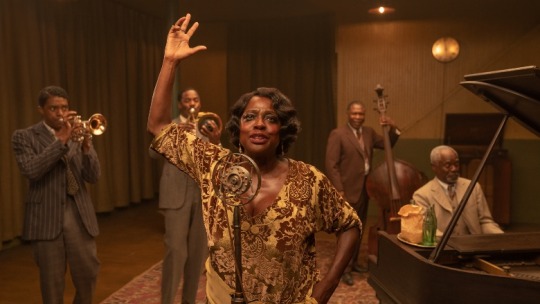
Next up is MA RAINEY’s BLACK BOTTOM, George C. Wilson’s adaptation of the 1982 August Wilson play that preceded Fences, which Netflix will give a theatrical release this week before it goes to streaming in December. Like Fences, this once again stars that film’s Oscar winner, Viola Davis, in the title role of Ma Rainey, a legendary blues and jazz singer in the late ‘20s who has come to a recording studio in Chicago to make a record with her band. The band’s hotshot trumpet player Levee (the late Chadwick Boseman) is more interested in breaking out on his own, and he does everything to grandstand and try to impress the label guy (Jonny Coyne) even if it means throwing the rest of the band under the bus.
Since I never saw Wilson’s play, I really didn’t know what to expect from this movie, although the fact that most of it takes place in a recording studio definitely had my interest piqued. In case, you’re wondering about that odd title, it’s actually a song in Ma Rainey’s repertoire that she wants to do one way, but her manager Irvin (Jeremy Shamos) wants to try Levee’s version of the song. Ma’s not having any of it, and a lot of the film involves her
There’s been quite a lot of chatter about Chadwick Boseman getting a posthumous Oscar nomination for his performance in this, and it’s probably well-deserved since he gives quite a showy performance as Levee, giving a couple moving monologues including one about his mother being sexually assaulted by white men. It’s a very powerful performance indeed.
Rainey is certainly an interesting character for Viola Davis to play, even if she’s not necessarily likable with her obstinate demeanor and the way she gloms over her eye candy Dussie Mae, played by Taylour Paige, and dotes over her nephew Sylvester (Dusan Brown). As interesting as those relationships are, I probably enjoyed the interaction between the musicians more, because Boseman is working with some greats like Colman Domingo, Michael Potts and Glynn Turman. It’s actually kind of interesting how it switches between Levee and the musicians and Ma dealing with Irving upstairs.
As much as the Wilsons are exploring some interesting topics about race and the treatment of black people in the times, the movie frequently feels dated and it feels like some of the ideas are never fully revolved, even as it builds up to a fairly shocking climax.
I wasn’t really sure what to expect from Ma Rainey’s Black Bottom, but it’s a perfectly fine dramatic piece, but I didn’t feel that it had the weight of other movies about race I’ve seen, including yes, Green Book (sorry, haters), and a lot of that probably has more to do with George Wilson’s direction than August Wilson’s writing.
Just want to quickly mention a couple movies I’ve already reviewed, which will hit the streamers this week, including Steve McQueen’s LOVERS ROCK on Amazon Prime Video, which I wrote about here, and Ron Howard’s HILLBILLY ELEGY, now on Netflix after a short theatrical release. I reviewed the latter here.
I’ve actually seen Lovers Rock a second time since the New York Film Festival, and I enjoyed it even more, as it’s really a well-crafted film even if it’s not as immediate maybe as Mangrove (now on Amazon Prime) and Red, White and Blue, which will be on Prime Video on December 4. I just love how Steve McQueen created a shorter piece that isn’t quite as deep as some of the others since Lovers Rock isn’t based on history but is just a nice young romance about two young people who meet and fall in love at a “Blues Night” party. It’s not as deep as the other movies I’ve seen, but is still good. Oh, and my interview with Steve McQueen is up at Below the Line finally, and I’m pretty proud of it, so check it out!
I don’t know if I have too much more to say about Hillbilly Elegy, but I hope people will give it a chance because even if it does have problems and isn’t perfect, it’s an interesting story, particularly for Glenn Close’s performance.
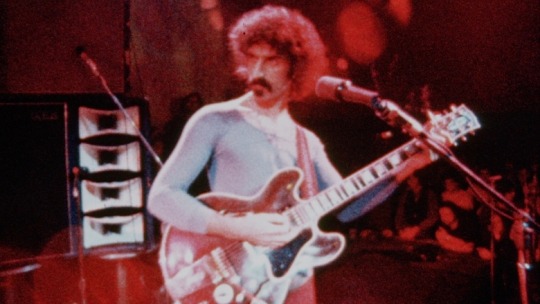
This week’s “Featured Flick” is Alex Winter’s doc, ZAPPA (Magnolia Pictures), an amazing film that takes a look at the life and career of the late Frank Zappa, best known for his quirky rock tunes but just at proficient at writing jazz and classical musical. I definitely went through a bit of a Zappa phase in my teens, and every once in a while, I would go back and see what had been released since his death in 1993, because his wife and widow Gail did a great job getting a lot of his unreleased music and live shows out there.
What shocked me when I saw Zappa was how little I really knew about the musician, because maybe he was a little bit of an enigma while he was still alive. I enjoyed the other doc, Eat That Question: Zappa In His Own Words, that came out a few years back, which was made up of public interviews Zappa gave, but it doesn’t really give as clear a picture of the man as Winter’s doc does.
For instance, Winter gets a lot of the musicians, including the amazing Ruth Underwood, who played with Zappa in the Mothers. You’d assume those musicians would presumably know the man best having toured with him for years, and yet, even they say that other than when they were rehearsing diligently or playing gigs, Zappa kept to himself. We also get a good sense of what a family man he was, since Winter was able to get Gail to talk to him before she herself passed way in 2015.
Zappa is an absolutely terrific doc that I hope music enthusiasts give a look even if they think they know what Zappa was about or maybe even those who didn’t care for his music. You might be pleasantly surprised by the tremendous amount of depth Winter brings to this talented musician and composer who still had a lot more to say. (And that’s an understatement!)
Incidentally, I’ll have an interview with Winter over at Below the Line very soon.

On the other end of the musical spectrum (more or less) is Gabriel Range’s STARDUST (IFC Films) -- not to be confused with Matthew Vaughn’s far better Stardust – this one starring Johnny Flynn, who played a young Albert Einstein in Genius: Einstein, this time playing a young David Bowie. Years before breaking it big with his album Ziggy Stardust and the Spiders from Mars, young David just can’t catch a break in the U.S., so he goes on a road trip in 1971 with his Ron Oberman (Marc Maron), the A&R guy from his U.S. label who hopes to get Bowie across to young American audiences.
I’m not quite sure how someone can screw up a movie about Bowie, one of my all-time favorite artists, but making a movie that a.) takes place in the most boring era of Bowie’s career and b.) Not actually being able to use any of Bowie’s beloved tracks, certainly doesn’t help matters. It also doesn’t help that the script just isn’t great, creating a fairly dull biopic that relies more on Maron’s personality basically playing the same character we’ve seen him play so many times before to stay even halfway entertaining. I couldn’t even get excited by Jena Malone, an actress I generally appreciate, as David’s wife Angie, because she plays her to be such a despicable and unsympathetic character.
If Maron is decent than Johnny Flynn is just plain flaccid as Bowie, playing him so mopey and aloof that when he finally emerges from his chrysalis as Ziggy Stardust – also with little of the flamboyance in his stage shows -- you just don’t give a rat’s ass anymore. Oh, and a lot of the movie is based on the theory that the history of mental issues in his family is what haunts the singer. Drab and dull, Stardust manages to make the most exciting rock star of the last half century seem like the most boring person on earth. It’s a flat-out failure as a biopic.
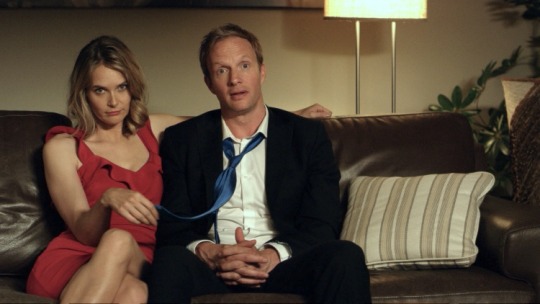
Joan Carr-Wiggins’ GETTING TO KNOW YOU (Gravitas Ventures) is a witty Canadian high-concept rom-com, starring Natasha Little and Rupert Penry-Jones as two strangers who have a chance encounter at a hotel in Northern Ontario. The latter plays New Yorker Luke Manning, who is back home for his high school reunion, but when his positively smashed high school girlfriend Kaila (Rachel Blanchard from Peepshow) shows up at the hotel hoping to rekindle their spark, he asks Little’s character Abby to pretend to be his wife.
I don’t have a lot to say about this movie which was a nice surprise and clearly a labor of love for the filmmaker. Honestly, my favorite part of the movie is how hilarious Rachel Blanchard is in it. I’m not sure what’s wrong with me that found her deliriously drunk nightmare of an ex to be kind of sexy, but maybe that’s just me. In fact, the movie might have been even funnier if the rest of the cast were able to keep up with Blanchard, but the connection between the two leads did grow on me as it went along. It definitely has some funnier moments like when Kaila’s bowling husband Kenny shows up, and then some of Luke’s other classmates pop in as well, but it does have to work very hard whenever Blanchard isn’t on screen. (I also enjoyed watching the soap opera that seemed to be going on between the employees of the hotel, which was perpetually funny.) Otherwise, it does feel a little flat whenever Blanchard is on screen.
The filmmaker’s lack of experience is sometimes obvious, because there are things like the repetitive music that I wasn’t so crazy about. Otherwise, this is a light and quaint indie that’s a little off the beaten track, but you won’t have any regrets if you make the effort to go looking for it.
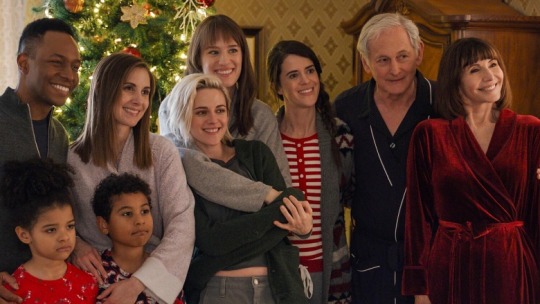
I’m thrilled to see actor Clea Duvall back behind the camera for her second film as a director, HAPPIEST SEASON, which was going to get a theatrical release through Sony’s TriStar Pictures at one point. Instead, it’s now going to be on Hulu starting Wednesday. (Today!) It’s a high-concept rom-com starring Mackenzie Davis and Kristen Stewart with Davis playing Harper, a woman who has not come out of her closet to her family, which makes it that much more awkward when she brings her girlfriend Abby (Stewart) home for the holidays.
As mentioned, this is a fairly high-concept comedy that uses the idea of someone coming out to their disapproving family we’ve seen in many movies, but does it in a way that can take it seriously but still allow for some funny moments. In fact, there are times when the comedy even goes into Meet the Parents territory in terms of the character humor.
I really enjoyed Duvall’s previous film, The Intervention, and once again, she has put together such as great cast to realize the script that she wrote with Mary Holland. In fact, Holland has a great role, playing Harper’s bubbly sister Jane, who steals so many scenes in terms of the humor that I was shocked that I only realized later she co-wrote the script with Duvall.
Mackenzie Davis continues to be every director’s secret weapon, because like in Jason Reitman’s Tully, she can literally deliver on every aspect of the movie, keeping the comedy aspects grounded but also deliver a really poignant performance. She also works really well with Kristen Stewart, maybe bringing out things in Stewart we just haven’t been able to see before.
Besides having Alison Brie play Harper’s older sister and Aubrey Plaza as an old flame, Duvall also had the foresight to get the amazing Dan Levy, recent multi-Emmy winner for Schitt’s Creek, to play Abby’s best friend, who is constantly there for her to kvetch and who shows up to pretend to be her boyfriend. (Oddly, there’s a lot of that sort of thing going on in movies this week.)
Happiest Season works as a perfectly fine albeit fairly traditional holiday rom-com in a similar way as The Family Stone. More than anything, Duvall continually proves her abilities as a filmmaker that can handle comedy and drama equally well.
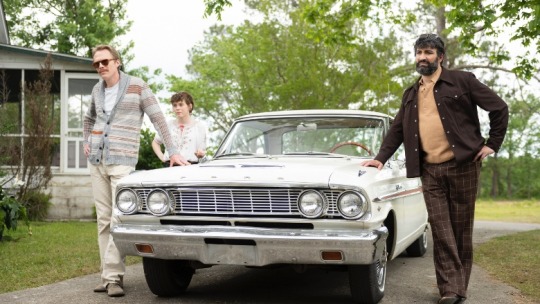
Next up, is Alan Ball’s UNCLE FRANK (Amazon), the Oscar-winning writer of American Beauty, directing only his second movie after 2007’s Towelhead – you might remember his HBO shows Six Feet Under and True Blood. This one, set in the ‘70s, stars Paul Bettany as the title character with Sophia Lillis from It Chapter One and Two playing his niece Beth, a teen from Creekville, South Carolina who worships her New York-based professor uncle. When she goes to college in New York, she attends one of Frank’s parties with her pseudo-boyfriend and ends up learning that Frank’s “roommate” Wally (Peter Macdissi) is actually his boyfriend. When Frank and Beth return to South Carolina for his father’s funeral, he has to try to keep his sexuality and relationship with Wally a secret from his family. Yeah, this does sound a little like Happiest Season, doesn’t it? It is, but only to a point.
At first, Uncle Frank is a cute but not-particularly-deep coming-of-age story about Lillis’ character as a fish out of water in New York City. Once Wally is introduced, he seems to be there just to make jokes and lighten the mood as it turns into a road trip. From his previous work, I’ve grown to enjoy Ball’s unconventional storytelling, but by comparison, this movie is very by-the-books, so it never really grabs the viewer.
The biggest problem with Ball’s latest--and it’s one that I see in a lot of movies these days--is that it doesn’t know whether it should be a comedy or a drama, and because it isn’t particularly funny, you expect it to fare better as a drama and yet, it doesn’t.
Ball has such a great cast including Judy Greer, Margo Martindale, Stevens Root and Zahn, all playing the duo’s racist Southern family, but they disappear for long sections of the movie, and then don’t do much when they return for the more dramatic last act where it turns into such a maudlin melodrama once Frank and Beth get back to South Carolina. As they mourn the dead patriarch, Frank keeps reflecting back on what drove him to New York in the first place, and we’re pummelled with so many flashbacks. Lillis’ character almost gets lost at this point, even this story is supposed to be told from her point of view.
Essentially, Uncle Frank falls somewhere quite literally between Hillbilly Elegy and Happiest Season but not being as good as either. It’s just disappointing that Ball didn’t have someone offering good advice on handling material that will constantly have you groaning, “What was the point?”

Screenwriter Matthew Michael Carnahan (The Kingdom, State of Play, 21 Bridges makes his directorial debut with MOSUL, which will debut on Netflix this Thursday. As you can figure out from the title, this takes place in Iraq in the fall of 2016 where an army of 100,000 Iraqi soldiers and militia men mobilize to liberate Iraq’s second largest city from ISIS along with the embedded journalist Ali Maula. Surprise, surprise, this is another movie from last year’s September festival season, too, and there also was a documentary from last year with the same name about the same story, too.
I’ve been a fan of some of the films Carnahan has written over the years, some mentioned above, but his directorial debut certainly sounds ambitious, since he’s working with an all-Arab cast. I look forward to watching and reviewing this one, hopefully before Friday.

Premiering on Disney+ this Friday after losing its theatrical release – this is becoming the norm for Disney, huh? – is Ashley Avis’ adaptation of Anna Sewell’s classic piece of literature, BLACK BEAUTY about a girl and her horse. The girl is played by Mackenzie Foy from Interstellar and The Conjuring, and Black Beauty the horse is voiced by Oscar-winning actress Kate Winslet. No, I did not make that up, and I can’t wait to watch this, to see how that works exactly. Look for my review later this week… hopefully.
On top of that, those Trixie Pixies at Disney+ have somehow managed to secretly pull together a Taylor Swift concert called folkore: the long pond studio sessions, which will premiere exclusively on Disney+ November 25. Oh, that’s today!
Debuting on Showtime this Sunday is Errol Morris’ new doc MY PSYCHEDELIC LOVE STORY, which takes a look at the Acid King Timothy Leary through the eyes of his lover, Joanna Harcourt-Smith, trying to figure out her part in his turn into a narc for the CIA. Another one I hope to get to soon because while I like Morris’ political films like The Fog of War and even the Steve Bannon doc American Dharma, this seems more in the vein of Tabloid, which I also enjoyed. Will try to watch this over the weekend and report back.
Also of note is that the doc She is the Ocean (Blue Fox Entertainment) will be hitting On Demand this week. I guess I never got around to reviewing it.
So, let’s see. We’ve had some good movies, we’ve had some not great movies, and we’ve had a few movies that I just didn’t get around to watching yet. What does that leave? How about two of the worst movies I’ve seen this year? Are you ready?

SUPERINTELLIGENCE (HBO Max) is the latest comedy from Melissa McCarthy and hubby director Ben Falcone, and boy, it won’t take you long to realize why New Line decided LONG before COVID not to give it a theatrical release, instead handing it over to its new streamer HBO Max.
In this, McCarthy plays Carol Peters, an average Seattle woman, who – I mean, honestly, does it even matter what she does? It’s irrelevant. Carol encounters an artificial intelligence being with the voice of James Corden that has just achieved self-awareness and wants to study Carol in order to understand humanity. But what are its plans… to save humanity or destroy it? Only Carol has the power to keep the world from finding out.
I honestly don’t even know where to begin except that I was a Melissa McCarthy stan for a long time before Bridesmaids; Superintelligence makes it all-too-obvious that she needs to stop making movies with Falcone. It’s not that he’s an incapable director, but he just doesn’t give her the actual direction she needs. The movie is just all over the place, starting with the physical comedy McCarthy has done so much in her movies, but then turning into a romantic comedy as the AI tries to reunite Carol with her college boyfriend George, played by Bobby Cannavale. Apparently, making The Heat with Sandra Bullock has made Falcone think his wife could or should be Sandra Bullock. No, she can’t. Throwing her into a ridiculous concept like this one that isn’t very solid does little to endear McCarthy to the fans she keeps driving away with bad movies like this.
I’m sure it doesn’t help that I really hate James Corden and hearing his voice over the course of the movie while also acting very META by referencing the ACTUAL James Corden, Carpool Karaoke, etc. Just none of it is very funny. Oddly, this is written by the same guy who wrote the duo’s earlier movie, The Boss, which I didn’t think was that bad, but mainly because McCarthy was paired with Kristen Bell for a lot of the movie.
On top of that, Superintelligence wastes its entire supporting cast from Brian Tyree Henry to Sam Richardson (from Veep) but also has Karan Son from Deadpool playing the EXACT SAME CHARACTER he played in Like A Boss, but only for a few minutes then he’s gone. At least it had the forethought to cast Jean Smart as the President, but the fact that I didn’t even like Bobby Cannavale in this might be the biggest sign of how much I absolutely detested Superintelligence.
There are movies you might hate when you see them in theaters but later realize that they’re probably funny enough cable. That is Superintelligence, except for the funny part. What else can I say except that “Superintelligence” is not a term I'd use for whoever greenlit this piece of crap.
Also debuting on HBO Max this week is the new thriller series The Flight Attendant (HBO MAX), starring Kaley Cuoco, who really hasn’t been doing much outside The Big Bang Theory, so this should give her a chance to show how funny she is. She plays a woman who wakes up in the wrong hotel and wrong bed with a dead man, so it already sounds like a great premise right there. I guess the entire first season will debut on Thanksgiving.
And yet, believe it or not, Superintelligence isn’t even the worst movie of the week! Nope.
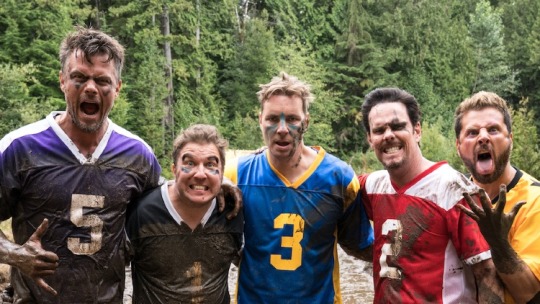
Apparently, Josh Duhamel’s new comedy, BUDDY GAMES (Saban Films/Paramount), played in some theaters over the weekend, but it’s now available on digital and On Demand. It’s Duhamel’s directorial debut, and it’s about as dude-bro as you can possibly get, as it has Duhamel, Dax Sheppard, Kevin Dillon, Nick Swardson, Jensen Ackles and Dan Bakkedahl as a group man-children friends who regroup five years after going their separate ways to bring back their “Buddy Games,” a series of obstacle and endurance tests that end up reviving ill feelings between a few of them.
I’m not sure how quickly I knew I was in trouble with this one, because at first, I thought that maybe Duhamel made a fun indie comedy about friendship ala the underrated A Good Old Fashioned Orgy. It didn’t take me long to realize that I was wrong as wrong could be, since by the halfway point it turned into something as innately immature as Jackass.
The general idea is that Duhamel plays Bob, the guy who found enormous success after splitting from his friends, marrying Olivia Munn’s Tiffany, but then he finds out that his old friend Shelly (Bakkedahl) has been put in rehab for a drug overdose. Turns out that at the last Buddy Game, Swardson’s character shot Shelly in the nuts with a BB gun, and he eventually lost his other testicle as well. That’s about the level of this low-brow comedy that rarely fails to grab the lowest hanging…um… fruit.
As it goes along, it just gets worse and worse to the point where there was one scene where the guys are at a bar while trying to get girls to buy them drinks that just got so disgusting, I almost turned it off. If I did, I would have missed the scene with a gila monster going after steaks strapped to the heads in another lame competition.
I can go on and on about how Buddy Games is but probably the worst infraction is that it does the most sexist thing possible by basically putting having women for a few moments and none that particularly advance anything.
Duhamel isn’t a bad director, and I wouldn’t be surprised if he got hired to direct another comedy someday soon, but this movie just very bad, very gross and almost excruciating to sit through at times. To call Buddy Games moronic, idiotic or even asinine, would be an insult to the morons, idiots or asses, who are likely to be the movie’s target audience.
On Friday, New York’s Metrograph is bringing back the 2017 4k restoration of Fruit Chan’s Made in Hong Kong as a ticketed screening running from Friday through December 3. You can also still catch Shalini Kantaya’s Coded Bias and the French New Wave anthology Six In Paris as ticketed screenings through December 3.
Up at New York’s Lincoln Center, you can catch its World of Wong Kar Wai with a couple films available this Wednesday, including his fantastic drama In the Mood for Love, but you can also get the 7-film Janus Bundle for $70 which is a saving over the individual movie cost of $12 apiece. Those seven films and five more will be shown over the course of December.
Other stuff out this week that I wasn’t able to get to include:
The Christmas Chronicles 2 (Netflix)
Last Call (K Street Pictures)
Faith (Vertical)
Saul and Ruby’s Holocaust Survivor Band (Samuel Goldwyn)
The Walrus and the Whistle Blower (Gravitas Ventures)
Life in a Year (Amazon Prime)
32 Weeks
Have a great Thanksgiving, everyone!
By the way, if you read this week’s column and have bothered to read this far down, feel free to drop me some thoughts at Edward dot Douglas at Gmail dot Com or drop me a note or tweet on Twitter. I love hearing from readers … honest!
#TheWeekendWarrior#Movies#Reviews#Zappa#MaRaineysBlackBottom#HappiestSeason#GettingToKnowYou#VOD#Streaming#Superintelligence#BuddyGames
0 notes
Text
[GOLDEN KAMUY] Noda Satoru x Machiyama Tomohiro interview

To celebrate the publication of Golden Kamuy’s fifth volume, Natalie arranged a Skype interview between Noda Satoru and film critic Machiyama Tomohiro, who’s a fan of the manga. They must use Skype because Machiyama lived in the USA at the time of the interview. Noda-sensei expressed his desire to speak with Machiyama after he found out that the critic is a fan of his work.
Noda: I heard you’ve read Golden Kamuy. I also love movies so I really want to have a talk with you.
Machiyama: That’s right. Although I have never stated on TV or radio that I’m reading Golden Kamuy, it seems like Ijuuin Hikaru-san (Japanese comedian, radio personality - ty.) talked on radio about how we conversed about Golden Kamuy when we met. You are from Hokkaido, right. Are you still living there?
Noda: No, Right now I’m working in Tokyo. I went to Tokyo when I was about 23 years old.

Machiyama: Did you go to Tokyo to become an assistant?
Noda: Yes. First I worked as an assistant for Kubo Mitsuro-sensei for two years. After that I changed places, and lastly I worked as an assistant for a long time at Kunitomo Yasuyuki-sensei’s place.
Machiyama: I see. Since you said you’re really fond of movies, are you heavily influenced by movies?
Noda: Yes, lately I watch a lot of director’s commentaries on DVDs. I learn a lot from careful explanation about how to make characters, the significance of scene production, etc from directors such as Michael Mann or David Fincher.
Machiyama: Yeah, many American directors are as kind as providing voiceover to give explanations even about dialogue-less scenes. For this talk, I tried to read Golden Kamuy again, and indeed there is homage to movies here and there. The ‘Youjinbo-hen’ arc where Hijikata Toshizou acted the lead was certainly a homage to Kurosawa Akira’s Yojimbo and the Spaghetti Western’s version A Fistful of Dollars. However, Hijikata’s tactic of breaking through buildings could not be found in either, so it’s interesting.

Noda: Because if there’s no difference at all, people will say that it’s just a plain rip-off. (laughs)
Machiyama: It’s different because there’s a fight between hand-to-hand combat master Hijikata and the sniper. It has a different appeal than Yojimbo.

Noda: Thank you for saying that.
Machiyama: But the little town where the wind wheezes by is certainly influenced by Yojimbo.
Noda: Whoa, you noticed that!

Machiyama: How did the theme of the work, “Survival in search for Ainu’s hidden gold”, come into being?
Noda: The name of the main character, Sugimoto Saichi, is actually based on my great-grandfather’s name. He’s originally from Kyushu, but he became a tondenhei (a soldier assigned to guard and develop Hokkaido – ty.) and moved to Hokkaido, and also served in the Russo-Japanese war. After my previous manga ended, while I was thinking about what to make next, my managing editor suggested “How about making a story about hunting next?”, and handed me a novel by Kumagai Tatsuya-san, 銀狼王 (Ginrouou, Silver Wolf King). It’s a story about the hunt for a surviving wolf with silver fur in Hokkaido during the pioneering age, and the name of the protagonist is Nihei. The name happens to be the same with that of a character that appeared in my previous work, Supinamarada!, I felt it like a destiny and thought that I should make a manga about it. Alright then, let’s combine the story of this hunter and my great-grandfather who returned from the Russo-Japanese war.

Machiyama: And then you also combined the story of the hidden Ainu gold and Hijikata Toshizou?
Noda: That’s right, gold rush and the Sankebetsu brown bear incident were also part of Hokkaido’s interesting history, so I also picked up those stories.
Machiyama: Is your great-grandfather’s experience in the Russo-Japanese war passed on through generations in your family?
Noda: Up to my father’s generation the story was well told, but I only knew that he went to the Russo-Japanese war. When I was about to write Golden Kamuy, I asked my dad about my great-grandfather. Then I found out that there are related documents still in Sapporo’s public records. There are records of details such as his participation in the 203-Meter Hill Battle and the Battle of Mukden and even the year he went home to Japan. But if only I hadn’t asked my father at that time, probably the story of my great-grandfather would have been stuck there.
Machiyama: And so it became a chance to tell his legacy.
Machiyama: When I read Golden Kamuy, I thought it’s interesting because I love Western films. Suit-wearing Hijikata slashing enemies face-to-face with Izuminokami Kanesada (his sword – ty.) on his right hand, and shooting distant enemies with a Winchester rifle on his left hand, is such a sight to behold. But then again there are also various other elements incorporated in the manga. First of all there’s the survival theme, then there are also the military, the Ainu culture, the period romance. And there’s also the hand-to-hand combat, the “dream match” between “Invincible Ushijima”, no, “Invincible Ushiyama” with Hijikata! They feel as real and grotesque as the depiction of human body destruction in splatter movies and Yoshimura Akira’s novel Kuma Arashi! (The novel is about the Sankebetsu brown bear incident. – ty.) And oh, let’s not forget the “bishoujo moe” component, Asirpa-san! I can’t help it since I’m a fan of Nakoruru. (An Ainu girl character appearing in the game Samurai Spirits. – ty.) For gun fetishists too, the details of firearms are also a delight! Isn’t it difficult to read materials about so many various elements?

Noda: Indeed. Although I listed my reference at the end of Golden Kamuy books, I only included the sources about Ainu. If other books are also listed, the manga would be too thick so I could not include them all. Even my bed is so full of books, it’s difficult to roll over and sleep on it. (laughs)
Machiyama: You actually also do quite a lot of field observation.
Noda: Yep. A lot of observation, observation, observation. I think it’s important to get direct experience on field myself. For instance, when I watched Kaguyahime no monogatari (The tale of Princess Kaguya) by Takahata Isao, I realized the troubles creators have to go through in doing research. Since readers can sense the seriousness of a creator, I decided to do it with all my might.
Machiyama: You also observed the Ainu people.
Noda: I am really thankful that my managing editor and editor-in-chief visited the Ainu people so many times themselves until they gained trust from them. Thanks to their effort, I could go drinking with people from the Ainu association, and they told me “Satoru-kun, go ahead and make the manga without hesitation.”
(Note: The way the Ainu people call Noda-sensei here – ‘Satoru-kun’ – shows that they’re already close with him. – ty.)
Machiyama: Just now I mentioned about how there are so many various elements that make up ‘Golden Kamuy’, and the depiction of food is also amazing. Is it a gourmet manga now or what. (laughs)
Noda: I just think depiction of food was a must if I was going to make a manga about hunting.
Machiyama: Have you ever tasted the food made of wild animals that appear in the story?
Noda: I’ve tried deer and bear meat to compare them. I’ve also eaten the head, brain, and eyeball of a badger. The meat was really hard, and the chef explained that badgers move their jaws a lot, so the meat around the area becomes hard.
Machiyama: Have you tried eating squirrel?
Noda: It’s forbidden to catch Ezo (Hokkaido) squirrel. But I want to try eating them. Speaking of squirrels, the protagonist in Winter’s Bone ate them.
Machiyama: That’s right. In the United States, there are certain areas that look like in Winter’s Bone. There are people living there who invented a tool that lets out sound that attracts birds during hunting and became rich because of that. They drive around in luxury cars but they still enjoy eating squirrels. They’ve lived in mountainous areas for generations, so the source of fresh meat that they’re familiar with is squirrel.
Machiyama: Previously we talked about your great-grandfather, but there are other characters who are modelled after real people as well. Even though he’s now a funny character through-and-through, isn’t The Escape King Shiraishi modelled after real-life Shiratori Yoshie who escaped prison so many times? That Shiraishi, who loosened his joints to be able to break into the building where Sugimoto was being held.
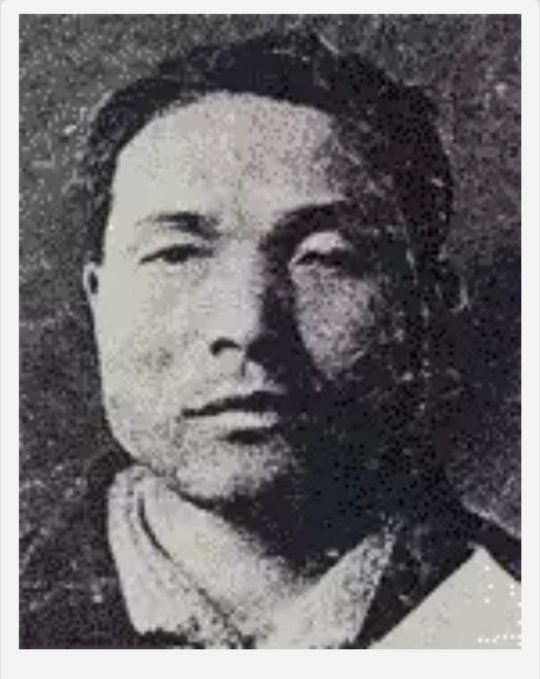
Noda: That’s right. Actually, for observation, I went to Abashiri Prison where Shiratori Yoshie was jailed. There are figures there that show how he escaped from the prison. Although Shiraishi is now very popular among readers, originally I didn’t plan to make such a character. I was thinking of making him a one-off character.
Machiyama: Although Shiraishi is a womanizer, all Golden Kamuy characters have perverted sexual preference, don’t they? While there is a murderer who gets excited by the desire to be killed, there’s also this man who sometimes sleeps with women but also tries to have sex with people regardless of their sex. Do you have any reason why you draw such perverted characters?
Noda: I simply like perverts. Since a long time ago I like reading books about psycho killers. It was easier for killers to be on the run during the old days than today. I think it’s hard to make such story nowadays because criminal investigation technology is too advanced. People can find out soon if you fake your name and such.
Machiyama: Strangely, I don’t think that any Golden Kamuy character is a bad guy.
Noda: I personally think it wouldn’t be interesting if I simply make flat-out bad guys. I draw the characters thinking that everyone must be likeable. Thus I become too attached to them, it’s difficult to kill them off.
Machiyama: There are several groups competing for the gold, and each has their own truth and views. While protagonist Sugimoto looking for the gold to help his childhood friend treat her illness, the opposing groups too, whether they’re unappreciated soldiers, or the bushi (samurai) left out of the new government, or those wanting to create independent Hokkaido that they dreamt of for the indigenous people, have ideals that are not themselves bad.
Noda: I’m wondering whether ‘the truth’ for each character makes readers unable to understand the plot. If I make characters with blatantly wrong ideas appear, wouldn’t it make the plot easy to read?*
Machiyama: Speaking of the out-of-the-ordinary, gag scenes are often put right after serious scenes in Golden Kamuy.
Noda: I’m worried that it wouldn’t be interesting if serious scenes just drag on, so I break them up with gag scenes. Such jokes might help create a good tempo for the story.
Machiyama: It’s like the feeling raised by the scenes when Sugimoto was fed bizarre food like squirrel brain.
Noda: I got the idea for that when I watched the TV program MAN vs WILD.
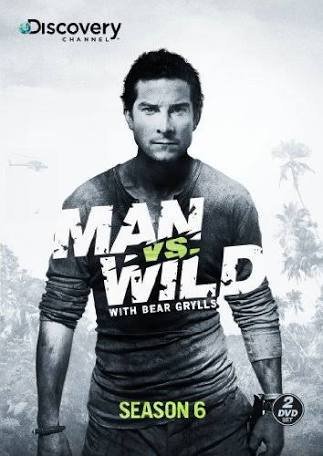
Machiyama: Ah, the one in which an ex-soldier tries to escape places like a desert or a tropical rain forest by using his survival skills.
Noda: In the TV program, they’d eat food like scorpions or caterpillars while saying “These are nutritious” with a disgusted face. I thought “Wouldn’t it be interesting if I draw a manga showing such faces?” I draw them by looking at photos of my own face doing weird expressions.
Machiyama: I think it’s funny that Sugimoto’s eyes turn dead each time he’s eating a bizarre food.
Noda: Other than those weird faces, I want to make a work that make people think “Aaah, that was interesting, I want to read it one more time.” Just like movies: Works that are really interesting and fun to watch, will still make you excited no matter how many times you watch them. For me, when it comes to serious, sad movies, no matter how perfect they are, watching them once is already enough.
Machiyama: Right now Sugimoto’s group is traveling to Abashiri, but I’m guessing the story will continue with such that weird tempo.
Noda: If they go straight they will arrive too early, so I think I will make them undergo a roundabout trip as much as possible while eating the animals they catch along the way. (laughs)
--end of interview--
* Note
I had to ask two of my friends, both professional translators with main language pair Indonesian & Japanese, about Noda’s last answer. He actually mentioned 予定調和, yotei chouwa, pre-established harmony, which seemed to be a Leibniz’s theory, and we found this part a bit difficult to translate. We had our discussion in Indonesian to find the closest meaning in our language, then I translated it into English. So any mistake in putting the idea into English is mine, not theirs.
161 notes
·
View notes
Text
Thumbnails 1/14/19
Thumbnails is a roundup of brief excerpts to introduce you to articles from other websites that we found interesting and exciting. We provide links to the original sources for you to read in their entirety.—Chaz Ebert
1.
"OUT 100: Emma González, Newsmaker of the Year": The phenomenal young gun control activist spoke with our own Monica Castillo for Out Magazine.
“Not everyone celebrated the arrival of a bold and confident queer Latinx woman on the national stage. Almost immediately after González’s first public appearances, trolls began attacking her online. In a Facebook post, Congressman Steve King’s campaign (R-Iowa) linked her to communist Cuba for wearing a patch of the country’s flag on her jacket. González, whose father is Cuban, defended herself and cited the elected official’s racist comments. ‘If somebody’s trying to challenge my Cuban identity, they are usually — if not obviously — racist,’ she said. ‘Look at the things he said, and what he called me. What he said was bottom-of-the barrel. He was not even trying. He went out of his way lots of times to call out various people and say things about minority groups.’ To González, identity is fluid and more encompassing than basic labels. ‘Identity to me means the way that you describe yourself when someone says, ‘Describe yourself,’’ she explains. ‘If I were to describe my identity, I would say that I am half Cuban, I’m bald, I’m bisexual, I’m 5-foot-2, I like to write, I like to partake in the arts, and I like to crochet. I would hope that if I were introducing myself to somebody, through those things, they would be able to get an understanding of who I am.’”
2.
"Does Erasing Cyber-Reality Erase Our Actual Reality?": A personal essay evocative of "Eternal Sunshine of the Spotless Mind," penned by Emma Olsson for Eileen Kelly's excellent site, Killer And A Sweet Thang.
“I think social media provides us with this peculiar way of storytelling, and perhaps it’s narcissistic, but the story is our own. I want to one day be able to look back at those odd little squares and read their stories of a time when I was 19 and 20 and 21 and in love for the first time. They hold deep connections to a memory, but they don’t necessarily signal a longing for a person. At least not for me. Something about the mourning of deleted pictures feels like a parody of our times. It’s impossible to imagine this scenario outside of a modern, digital context. In a time when online and offline lives are rich enough to be distinguished from each other, the act of removing little pieces of evidence from this online space feels particularly jarring. A deleted photo translates into something much deeper in meaning, to the deletion of proof of our existence together. I’d always tried to hold myself to the doctrine that one day, after the hurt had softened, I’d be able to look back on photos and relive the memories with gratitude. That I’d be able to see the soft things, the beautiful and happy things, not only the sad. Photos are potent in that way, and I hoped (and still do) to feel neither removed from this person nor bound to him. I hoped to just feel grateful, and it hurt me to think that he didn’t feel the same. That he wanted to cut me out of his memory — even if just on social media.”
3.
"'What 'Moonlight' Gave Us Was the Confidence to Execute Our Ideas Without Fear': Writer/Director Barry Jenkins on 'If Beale Street Could Talk'": A wonderful interview with the Oscar-winning director conducted by Jim Hemphill for Filmmaker Magazine.
“We treat the sound the same way we treat the cinematography, which is with the idea that it should be a reflection of the main character’s consciousness. In terms of the cinematography, when Tish is remembering the more beautiful and tender times with Fonny, those scenes are overly lush and overly saturated because they function as memory — when we remember things, we don’t remember them as a documentary. There’s more light in the flashbacks, and much more shadow in the present-day scenes, where Tish and Fonny are in a kind of purgatory. As far as the sound goes, when I’m making a film, I’m not just considering the screen — I’m considering the house, the actual environment where the audience is going to watch the movie. One of the things we decided right away was that the voice-over narration in the film needed to be experienced in a different way than the dialogue, so if you’re sitting in an auditorium it feels like you’re inside her head. Her voice is coming from all around the room, whereas the dialogue is coming from the front channel, and it’s a very different effect. In other scenes we would stoke up the reverb and things like that, just to reflect what the characters are feeling.”
4.
"Becoming parents completely changed who we are": A beautiful letter from Mary Barnes to her husband, published at Motherly.
“These are the parenting trenches. The baby years. These years can make or break us. And can I be so bold as to say: I think they're making us. They're making us learn how to communicate better. How to find common ground when we disagree about real stuff, like the ways we want to raise our children. We're invested in not only the outcome but the short term effect. We're a team. They're making us think about the future. Not just the fun stuff, but the difficult stuff like estate planning, life insurance, and college funds for the kids. They're making us challenge ourselves to provide our children with comfort and opportunities. We've always worked hard but the stakes have never been this high. You know I'm the optimist, the dreamer, while you consider yourself the realist—but I think we can agree on this: going through some of the tough stuff with you by my side has shown me that we are stronger than the tough stuff. We can get through it. We can get through anything. As long as we hold on to each other. Motherhood transformed me. Fatherhood transformed you. And having kids completely transformed our marriage. We'll never be who we were on our wedding day again. Time marches forward—only forward. I miss the carefree version of ‘us,’ but I love this version even more. Because we know what we're made of now, and in so many ways we didn't before.”
5.
"Independent films screened at Oakton College's annual pop-up: 'The festival is all about broadening horizons'": Our contributor Donald Liebenson reports on Michael Glover Smith's indispensable festival for the Chicago Tribune.
“Josephine Decker’s ‘Madeline’s Madeline’ that was screened during the film festival is the type of film that Smith says he envisioned when he launched the free event. ‘I wanted to show independent and experimental films that are exciting and a little bit challenging; movies that are different from what typically would play (at the local multiplex),’ Smith said. ‘The festival is all about broadening horizons.’ Smith, himself, is the author of ‘Flickering Empire,’ which chronicled the untold story of Chicago’s silent film industry, and the film blog ‘White City Cinema.’ He has also directed two film festival award-winning productions: ‘Cool Apocalypse’ and ‘Mercury in Retrograde.’ The filmmaker and instructor said he was inspired to start the ‘Pop-Up’ festival after inviting Harold Ramis’ wife Erica to speak to his student about a documentary she had produced on The Joffrey Ballet. ‘She is the daughter of the late film producer and director Daniel Mann, and she talked about growing up in that household, her life with Harold and being on his film sets,’ Smith said. ‘But it was in a classroom of 12 people, and I thought this was a conversation that should be held in an auditorium and open to the public.’”
Image of the Day
Chris Elliott is the latest amazing guest on Sam Fragoso's essential "Talk Easy" podcast, with illustrations by our Far Flung Correspondent Krishna Shenoi. Click here for the full conversation.
Video of the Day
youtube
Not only did Glenn Close's acceptance speech for her surprise win in the Best Actress (Drama) category for her brilliant performance in "The Wife" bring the Golden Globes audience to its feet, it could also very likely help the actress win her very first Oscar. And boy is she well overdue for one.
from All Content http://bit.ly/2SQvyIQ
0 notes